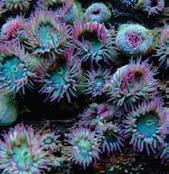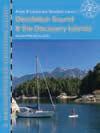












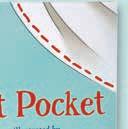

























Like many residential school Survivors, my mother, Mary, never spoke about her experiences there until very late in life. She was recovering from an injury when she shared the story of the secret pocket with my brother and me. With my mother’s blessings—specifically, “Well, they gotta know”—I shared it with my students of all ages and other teachers. Soon the staff at the local university asked if they could gift the story to their Indigenous graduates. A secret pocket was sewn into the stole each graduate wore with their gown. The pocket held a copy of my mother’s story. My husband, who is also a teacher, and I have since brought the secret pockets to the twelfthgrade graduates at our high schools.





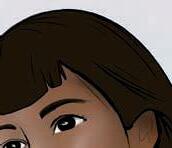

from the Author’s Note





W ����fi������������������������r��������������������������������i������������������������������h�� mo��������������h��������������o����������9781459833722 • HC • $21.95 P������������ ����������������������i
Sara Ellison
Snorkelling Adventures
Around Vancouver Island and the Gulf Islands:
The Ultimate Guide (Harbour $26.95)
Jennifer Manuel
The Morning Bell Brings
the Broken Hearted (D&M $24.95)
Sam George, Jill Yonit Goldberg, Liam Belson, Dylan MacPhee, Tanis Wilson
The Fire Still Burns: Life In and After Residential School (UBC Press $19.95)
Alexander Globe Gold, Grit, Guns: Miners on BC’s Fraser River in 1858 (Ronsdale Press $26.95)
tRika Ruebsaat
My Paddle’s Keen and Bright (New Star $24)
Lynn McCarron British Columbia Lullaby (Sandhill Book Marketing $14.95)
Peggy Janicki & Carrielynn Victor
The Secret Pocket (Orca $21.95)
Ellen Schwartz Galena Bay Odyssey: Reflections of a Hippie Homesteader (Heritage House $26.95)
Connie Kuhns Rubymusic: A Popular History of Women’s Music & Culture (Caitlin Press $26)
Imagine a mother set to enjoy her morning coffee when out of the blue her daughter announces she tried to commit suicide. That’s the explosive start to Yasuko Thanh’s fourth book, To the Bridge (Hamish Hamilton $24.95), about a troubled working-class family with all kinds of secrets. Rose is proud of sixteen-year-old Juliet, who’s top of her high school class and on a scholarship track to university. Only Juliet suffers from clinical depression and has drug addiction problems, and others have noted that she is “full of rage.”
Suicide is not new to Rose, as her mother had taken her life when Rose was a young girl.



Now Rose’s daughter is on the same path. Despite these troubles, the picture Thanh conjures is of a struggling family that stays together. “When someone you know is in trouble, shut your mouth and open your arms,” Rose is fond of saying. Inspired by her favourite song, “Never Give Up,” Rose believes her family will continue to move on: “We’ll pick up the pieces and wait for time to scatter our broken hearts over a field to watch something grow.”
Thanh previously published two other books of fiction and a memoir about dropping out of school and living on the streets at age fifteen. Thanh won the 14th annual City of Victoria Butler Book Prize in 2017 for her historical novel, Mysterious Fragrance of the Yellow Mountains (Hamish Hamilton, 2016).
9780735244672
tPeter A. Victor Escape from Overshoot: Economics for a Planet in Peril (New Society $32.99)
Hilary Peach
Thick Skin: Field Notes from a Sister in the Brotherhood (Anvil $22)
Jónína Kirton
Standing in a River of Time (Talonbooks $19.95)
The son of a Turkish immigrant father and a Quebec-born mother, Terry Salman grew up in a modest Montreal home; joined the US Marines and fought in Vietnam from 1965–66; and earned a BA from Chaminade University in Hawaii on his way to becoming a mining finance icon in Canada. Halfway through his career, Salman began contributing to public services and became chairman of the Vancouver Public Library Foundation and the St. Paul’s Hospital Foundation (where he helped fund a hospice for AIDS patients). He chronicles his life in the memoir What We Give: From Marine to Philanthropist (Page Two $34.95).

Publication Mail Agreement #40010086
Return undeliverable Canadian addresses to: BC BookWorld, P.O. Box 93536, Vancouver, B.C. V6E 4L7
BOOKWORLD
Publisher: Beverly Cramp
• Editor / Design: David Lester
Produced with the sponsorship of Pacific BookWorld News Society.
Publications Mail Registration No. 7800.
BC BookWorld ISSN: 1701-5405
Advertising & editorial: BC BookWorld

9781774581872
Contact: bookworld@telus.net
Annual subscription: $25
Two young Roma teens, Nikola and Saida, live with their grandmother—their Baba—in a squatters’ settlement near a bridge in Belgrade, Serbia. Their parents abandoned them as babies without birth certificates, and they have little to no schooling. But they have dreams. Nikola wants to be a trumpet player like his grandfather; Saida wants to go to school and live in a normal home. In Carboard City (Tradewind $14.95), for ages 12–17, Katarina Jovanovic tells their story while revealing the racism, injustice and inhumane conditions that Eastern Europe’s Romani people continue to suffer. Born and raised in Belgrade, Jovanovic worked in radio before immigrating to Canada. She won the 2009 Christie Harris Children’s Literature Award for The King Has Goat Ears (Tradewind, 2008) and the 2017 Chocolate Lily Award for The Blue Vase (Tradewind, 2015). She lives in Vancouver.
9781990598104
Indigenous Editor: Latash-Maurice Nahanee
Contributing editors & writers: Alexander Varty, John Moore, Heidi Greco, Mark Forsythe, Graham Chandler, Caroline Woodward, Valerie Green,
Proofreaders: Erin F. Chan, Graham Chandler
Accounts: Ingela Kasparaitis
Consultants: Ken Lapp, Kenneth Li
Deliveries: Ken Reid, Acculogix
We gratefully acknowledge the unobtrusive assistance of the Canada Council, a continuous partner since 1988, and CreativeBC, a provincial partner since 2014.
In-Kind

Trevor Marc Hughes
A classic adventure story set in the wilds of the north.
“Rescues from obscurity the life and times of Hamilton Mack Laing, the exploratory naturalist who breathed science into the epic first ascent of Canada’s highest peak.”
ZAC ROBINSON, Royal Canadian Geographical Society
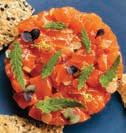
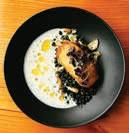


Debra Amirault Camelin
A story of heroism and heartbreak for 13-yearold Acadian Nathalie Belliveau that is grounded in the historic facts of the Acadian expulsion.
“Seamlessly weaves fact and fiction drawing us into the lives of her vivid characters.” CAROLINE PIGNAT, Governor General’s Award winner
www.ronsdalepress.com
Sabyasachi Nag
“Sabyasachi Nag’s story cycle is Arundhati Roy as if written in the mode of Alice Munro.”
GEORGE ELLIOTT CLARKE, Governor General’s Award winner
“A sharp and incisive collection from a compelling new voice in Canadian fiction.”

ANNABEL LYON, Rogers Writers’ Trust Fiction Prize winner
“A collection of haunting, powerful stories by a writer to watch.”
ALIX OHLIN, Giller-nominated novelist
Martha Attema
It is February 1953 in the Netherlands and a brutal flood exposes a dark family secret for 16-year-old Klara.


“This is an unforgettable story of survival.”
HEATHER STEMP, author of Under Amelia’s Wing
Twin Islands, nicknamed “Twin,” are two islands so close together that during low tide, they are joined. This tranquil place of splendour is situated southeast of Cortes Island, just east of Vancouver Island. Its fascinating past is chronicled by Jeanette Taylor in Sheltering in the Backrush: A History of Twin Islands (Harbour $24.95). Twin’s “live-wire characters” run the gamut from “ancestors of the Tla’amin people to German and British royalty, an Irish aristocrat (whose murder remains a mystery), spies and espionage, newspaper moguls, movie stars and a visionary heiress,” writes Taylor. It is also a story of how Twin “was transformed from a subsistence homestead into a resort of the wealthy” when millionaire Americans Dick and Ethel Andrews bought the islands in 1936 from a homesteader family. The Andrews hired people from nearby Lund to log trees on Twin and build, mainly by hand, a rustic lodge from 1937 to 1939. Many years and owners later, a wealthy heiress rescued the islands from logging so that they continue to be a place of natural beauty and diversity.
9781990776113
Shawn Dogimont lives in two places: Lasqueti Island, the Gulf Islands’ centre of counter-culture; and Paris, a world centre of culture. The publisher of Paris-based Hobo (an “outsider” magazine about lifeways more in tune with the natural world—imagined in 2002 on a chairlift in Whistler), Dogimont has released a collection of his writing and photographs, Becoming Pictures: A Travelogue (Orenda Press $50). He chose images that represent a kind of autobiography including, alongside Dogimont’s photography, family images taken by other people. TV and movie stars like the late Jeanne Moreau, Jeff Bridges, Norman Reedus, Isabelle Huppert and Tilda Swinton are mingled with shots of Dogimont’s mother and father, his friends and his BC neighbours, such as Bob Fawkes ( left ). Dogimont says he loves going to visit Fawkes and notes that his neighbour is “completely self-reliant and grows almost everything he eats and certainly everything he smokes.”
9791041510726
Stories of Sasquatch, also known as Bigfoot, endure in popular culture, Indigenous stories and folklore. People continue to report sightings of this large, apelike animal, although such accounts are often treated as hoaxes, delusions or

DENMAN ISLAND & SECHELT
Journalist and editor Susan Lundy will be reading from her humorous book about life on the Gulf Islands, Home on the Strange: Chronicles of Motherhood, Mayhem, and Matters of the Heart (Heritage House), at the 2023 Denman Island Readers & Writers Festival (July 21–23). This festival, launched twenty years ago by the Denman Island Community School, remains small but attracts national literary stars such as Giller prize winners Suzette Mayr (The Sleeping Car Porter) and Omar El Akkad (What Strange Paradise). Canada’s longest running summer gathering of Canadian authors, the Sunshine Coast Festival of the Written Arts in Sechelt, is now in its 41st year. On from August 17–20, this year’s authors include John Vaillant (Fire Weather), Janie Chang (The Porcelain Moon), comedic brothers Ian and Will Ferguson (I Only Read Murder), Carrie Mac (Last Winter) and accomplished short fiction writer Corinna Chong, whose debut collection of short stories is The Whole Animal (Arsenal Pulp).

Poet Tolu
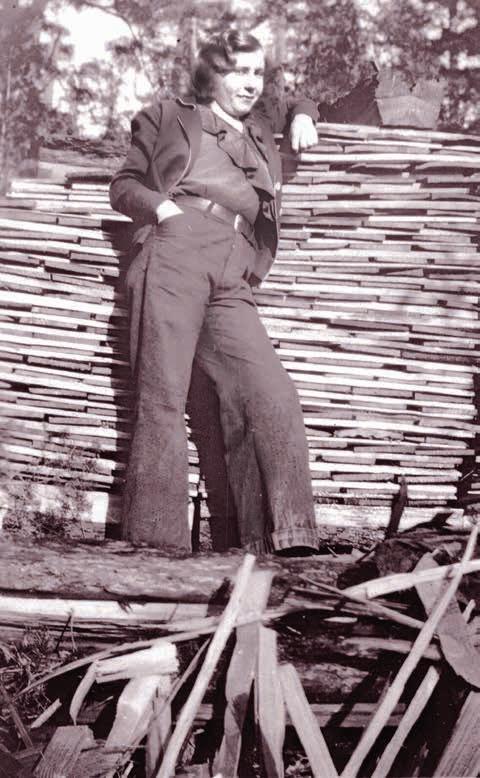

Oloruntoba (Each One a Furnace) will be at the Denman Island Readers & Writers Festival.

confusions. For the most part, the scientific community dismisses these reports. However, some scientists do believe there’s evidence for Sasquatch in North America, including the late Comox Valley–based wildlife biologist, John Bindernagel (1941–2018). In his lifetime, Bindernagel was the “go-to guy” for news media about Sasquatch. How Bindernagel came to devote so much of his life to this legendary creature is the subject of a new biography, Sasquatch Discovered: The Biography of Dr. John Bindernagel (Crypto/Hancock $26.95).

Largely a tribute to Bindernagel, the book is another addition to the extensive collection of Sasquatch titles published by Surrey-based Hancock House.
9780888397515
Where is Robert Hunter ? That’s a question that was frequently asked during the late environmentalist, journalist, filmmaker and bon vivant’s lifetime, and the answers would be as various as his accomplishments. Hunter might be on a converted fishing boat, the Phyllis Cormack, sailing into the blast path of a planned nuclear weapons test near the unspoiled Aleutian archipelago. Or he might be on the same vessel, three days off the coast of California with two days’ worth of diesel in the tanks, facing down an armed and belligerent Russian whaling fleet. He might be crashing a trail bike on a wild ride in the Bahamas, or canoeing one of the great wild rivers of the Canadian North, keeping a wary eye out for hungry polar bears—while cradling a rifle, secretly unloaded for his own safety by the expedition’s guide. Or he might be explaining the morphogenetic field theory to his kids.

All of these situations—and many, many more—are memorialized in Mr. Mindbomb, a collection of mostly fond anecdotes assembled by Hunter’s widow and frequent partner in adventure, Bobbi Hunter. Which makes it downright odd that “Where is Robert Hunter?” is also the question that kept popping into this reader’s mind as he made his way through this book’s 304 pages.
Don’t get me wrong; there’s a lot of Hunter here. Just as his ashes were scattered into several of his favourite waterways following his death in 2005, so too are these memories distributed amongst a motley crew of characters, ranging from former television tycoon Moses Znaimer and Sea Shepherd skipper Paul Watson to various newsroom cronies and Hunter’s erstwhile comrades in Greenpeace, which he helped organize and ostensibly named. Most notably, his children Emily, Will, and Justine weigh in with some of Mr. Mindbomb’s most intimate moments, and it’s there that we come closest to the real Hunter—not just one of the most charismatic of the early environmental movement’s many charismatic megafauna, but a flesh-and-blood, foible-ridden and loving human being.
There are also some passages in which the contributors are really telling their own stories, with Hunter in the supporting cast. That’s normal, as anyone who has ever attended a wake knows, and it’s understandable. Why not bask in the reflected glory of someone as passionate, entertaining and outspoken as Hunter seems to have been? But for those of us without their own Hunter stories to tell, who remember him as a rally speaker or bathrobeclad TV presenter or Vancouver Sun columnist, those of us whose memories are unpolished by once-upon-a-time proximity, more seems necessary.
And more, here, means more context.
The various contributors try. Once you’re past a hagiographic introduc-
tion by the Trinity College theologian and ethicist Stephen Scharper, Watson does a nice job of outlining what a book like this might accomplish: it could, he argues, “lay down the stepping stones for a brighter, greener, kinder and more progressive future.”
Another of Hunter’s early Greenpeace colleagues, the late Myron MacDonald, sensitively outlines some of the contradictions in his friend’s nature, attributing them to his emblematically Canadian background: half Québécois, half Anglophone. (Or, in other words, half Catholic and half Presbyterian, a combination that might perhaps explain both Hunter’s mystical side and
his savvy pragmatism.)
There is further anecdotal gold, but what Mr. Mindbomb lacks is an organizing principle beyond the loosely chronological. Reshuffled by a professional biographer or historian—and with a less loving hand on the editorial controls—all of this action could make for a gripping read as well as a useful overview of Canada’s early environmental movement. Thrown knives! Mind-melding with orcas! Tense staredowns on unstable pack ice! Many pricks kicked against and, finally, six years of dauntless fighting against the cancer that finally killed him!
Come to think of it, there’s a movie
here, too. But as a book, Mr. Mindbomb is missing a plot. Missing, too, is a sense of Hunter’s literary skill. We hear over and over again how our hero was an inspired polemicist, but actual “mindbombs” are few. One useful takeaway is that Hunter’s last will and testament, 2003’s Thermageddon: Countdown to 2030 (Arcade Publishing), is an unusually clear-headed and prescient warning of the coming environmental collapse, but it is not quoted extensively. Despite its obvious timeliness, Thermageddon appears to be out of print. Hopefully the release of Mr. Mindbomb helps rectify this.
Also useful, and as yet unavailable, would be a collection of Hunter’s journalism. In an age of advertorial writing and AI-generated babble, his sharp, fierce commentary could provide a welcome example to younger writers who would like to follow in his footsteps.
I’m glad to have these stories available, and perhaps they’ll prove inspirational, too. But there’s more to be done when it comes to keeping Bob Hunter’s legacy alive. 9781771606240
Alexander Varty is a senior West Coast arts journalist living on unceded Snuneymuxw territory.

Friends and family share stories about the late ecohero Bob Hunter, but more needs to be done to keep his legacy alive, argues reviewer Alexander Varty.tBob Hunter pilots the Phyllis Cormack to Amchitka, Alaska to stop nuclear testing, 1971.
Bob Hunter got the nickname Mr. Mindbomb when he said “We’re storming the minds of millions of people. Instead of lobbing bullets and bombs, were lobbing mind bombs, revolutionary images that will explode in people’s heads.”


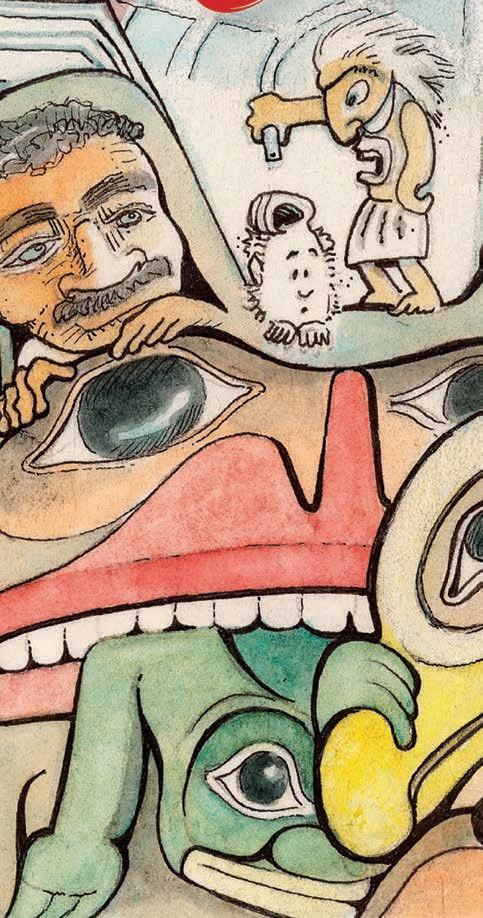









rocky mountain books
Mr. Mindbomb
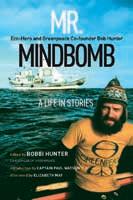
Eco-hero and Greenpeace Co-founder Bob Hunter
Bobbi Hunter, Paul Watson, Elizabeth May
A collection of essays detailing the achievements of a renowned environmental hero.
$30 pb $14.99 ebook
touchwood editions
Drawing Botany Home
A Rooted Life
Lyn Baldwin
A beautifully illustrated natural history memoir about growing-up in the southern interior of British Columbia.

$30 pb | $14.99 ebook
Time to Wonder - Volume 1
Suzanne
The first family guidebook to BC's regional museums for Thompson-Okanagan, Kootenay, and Cariboo-Chilcotin. $22 pb
Time to Wonder - Volume 2
Suzanne
The second family guidebook to BC's regional museums for Vancouver Island, Salt Spring Island, Alert Bay, and Haida Gwaii $22 pb

Crip Up the Kitchen
Tools, Tips and Recipes for the Disabled Cook
Jules Sherred
Recipes to make the kitchen accessible and enjoyable for disabled and neurodivergent cooks.

$35 pb | $14.99 ebook
The Coastal Forager's Cookbook


Feasting Wild in the Pacific Northwest
Robin Kort
Recipes that showcase foraged ingredients from the Pacific Northwest coast.
$40 hc | $17.99 ebook
The Coastal Forager’s Pocket Guide
Robin Kort
A handy waterproof pocket guide to foraging on the Pacific Northwest coast. $10 pamphlet
Heaven on the Half Shell
The Story of the Oyster in the Pacific Northwest
David George Gordon
A history of how oysters shaped the environment, cultures, and economies of the Northwest. $35 pb

Four Seasons by the Salish Sea

Discovering the Natural Wonders of Coastal Living
Carolyn Redl
Part travelogue, part natural history, this enchanting book explores island life over the course of a year, with stunning photography throughout.
$32.95 pb | $16.99 ebook
A Complex Coast
A Kayak Journey from Vancouver Island to Alaska
David Norwell
A soul-searching personal account of a 1,700-kilometre kayak journey, illustrated with whimsical watercolours.

$29.95 pb $13.99 ebook
Kimiko Murakami
A Japanese-Canadian Pioneer Haley Healey; illus. by Kimiko Fraser
The inspiring and true life story of Kimiko Murakami, a homesteader and internment camp survivor, charmingly illustrated for a young audience.

$19.95 hc $9.99 ebook
Lilian Bland
An Amazing Aviatrix
Haley Healey; illus. by Kimiko Fraser
The amazing life story of Lilian Bland, the first woman ever to design, build, and fly her own airplane, beautifully illustrated to inspire young readers.
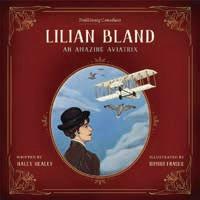
$19.95 hc | $9.99 ebook

Arailroad-workerturned-merchant and his wife, chanting laundrymen who smoked bamboo water pipes, and a teenaged house cook and servant whose murder went unsolved are some of the historical people remembered in award-winning author, Lily Chow’s new book about Chinese settlers.
Hard Is the Journey is a richly detailed account of the challenges and achievements of Chinese immigrant settlers in the Kootenay region of British Columbia. Chow has written other histories on this subject, focusing on north-central BC, Sojourners in the North (Caitlin, 1996); the north west, Chasing Their Dreams (Caitlin, 2000); and the Fraser Canyon and Okanagan, Blossoms in the Gold Mountain (Caitlin, 2018). In this book, known histories of BC’s mainstream society are interwoven with original research about early Chinese communities— their residents typically segregated and coping with systemic racism. A map of the Kootenay region provides a geographical introduction. The five locations chosen for study based on well-populated, early Chinese settlements are: Cranbrook, Revelstoke, Nelson, Rossland and the ghost town of Fisherville near Fort Steele.
Much of Chow’s research relied on archival local newspapers. She also utilized the Chinese Times of Vancouver, offering the reader another valuable point of view. Interviews with Chinese Canadian residents about their family history also deliver important insights, including that of Cameron Shan Mah (1946–2019), a prominent chef and community pillar of Nelson. Blackand-white photographs, many pulled from local archives, are sprinkled throughout the text. A striking sepiatone photograph on the book cover (circa 1910s) portrays a bejewelled Jung Ling, wife of Revelstoke merchant Wing Chung and mother of four sons. Dressed in a patterned blouse with long sheer sleeves and a skirt, her steady gaze suggests a woman of forbearance and grace.

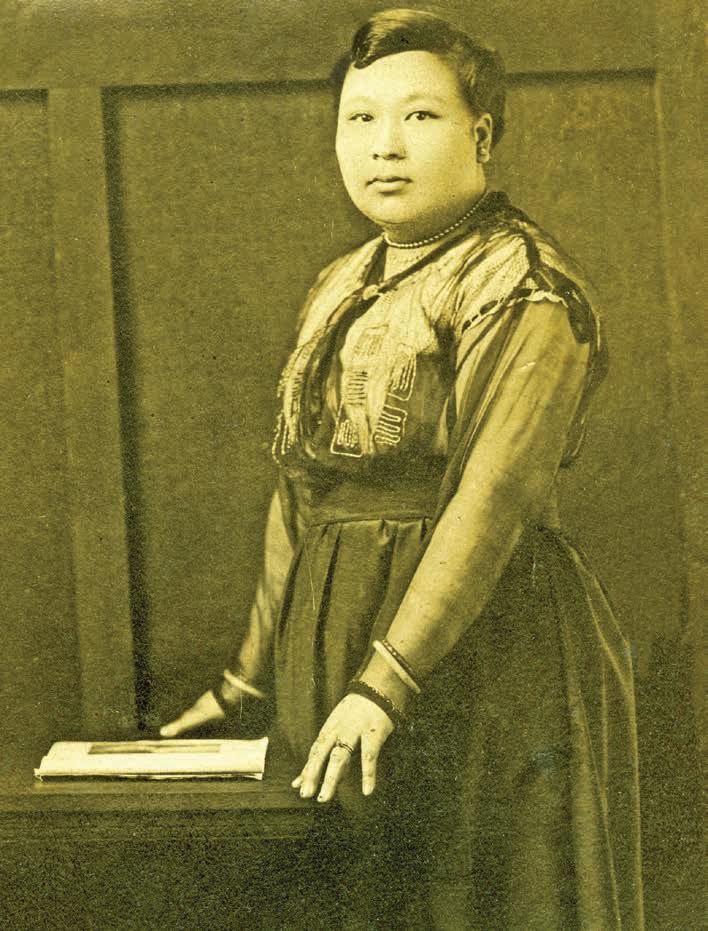
The earliest immigrants to the province came from villages in the Guangdong region in southern China for the gold rush of the 1860s and, later, to labour on the Canadian Pacific Railway. Chinese railway workers were notably absent when photographs of the ‘last spike’ event were taken following completion of the CPR rail in 1885. Yet Wing Chung, a laid-off railway worker (and later, merchant husband to the previously mentioned Jung Ling), said he was standing in the crowd of white people in attendance. Chow discovered this anecdote on a research visit to the Revelstoke Museum and Archives.
Chinese men also worked on the Dewdney Trail, at one time the main
route across BC, running from Hope to Wild Horse Creek, near Fisherville in the southeast corner of BC. After the trail’s completion in 1865, some of the men were drawn to mining for gold in the Fisherville area. They faced hardships and mistreatment from white miners who “jumped” their claim, then occupied it for themselves. However, the author also cites instances of their financial success and friendly relations. For example, several mining companies at Wild Horse Creek were owned by Chinese men—including the Hang Company and the Quong Yung Tong Company. Individual miners were known to go back to China with substantial cash in their pockets as well. As for friendly relations, Jack Lee, among the first to mine in the area, was regarded with sympathy by the wider community. When Lee passed away in 1929, the Cranbrook Courier wrote: “His death is deeply regretted by many who knew and liked the old fellow who was almost
as much of a landmark of Wild Horse gulch as the mountains above his lonely cabin.”
As Chinese labourers dispersed around the province following work on the CPR railway, many built new lives in the Kootenays, taking jobs in placer mining and establishing market gardens, laundries and restaurants. The Chinese joss house in Revelstoke, built in 1901, was a hub for the Chinese community and served as the location of the Chee Kung Tong (Chinese Freemason Society). Given the hostile flare-ups by townspeople toward Chinese residents who lived in crowded, impoverished quarters north of Revelstoke, the joss house played an instrumental role as a place of prayer, ceremony and advocacy.
The unsolved murder in 1900 of Mah Lin, a 19-year-old cook and servant in the Rossland home of single mother Mary Chenowith , is given a second look by the author and exposes racial injustices. Also
sketched from this era are Rossland’s nine Chinese laundries, the men labouring seven days a week and sleeping on hard wooden bunks in their shops. While washing customers’ clothes, “they hummed, sang or chanted, and they smoked tobacco with bamboo water pipes during breaks,” Lily Chow writes.
The government’s legislative policies—from the discriminatory implementation of the Head Tax in 1885 to the granting of the vote in 1947—are layered into the chronicles, and so are depictions of political upheavals in China and their impact abroad.
The dense tapestry of material in Hard Is the Journey is remarkable—and sometimes unwieldy. A brief conclusion following each chapter assists the reader to a degree, but could benefit with the author’s observations of themes and insertion of examples from the content. Chow’s meticulous and fascinating book nevertheless offers fertile groundwork for a future of truly inclusive BC histories.
9781773860749
July 20-23, 2023
Writing Week with Angie Abdou Moderators
Angie Abdou
Brad Hornick
Des Kennedy
Noah Ross
Music
• Randy Duncan Trio
Kevin Mitchell
• Tai McGillivray, Mark Kimmins, & Jenny Lester
Angie Abdou
Omar El Akkad
Seth Klein
Tsering Yangzom Lama
Susan Lundy
Suzette Mayr
Bruce McIvor
Tolu Oloruntoba
Ruth Ozeki
Britt Wray + Readings from Denman
Authors
Writing Week $450
Three Day Pass $125

Main Stage Events $25
Solo Readings $15
Workshops $80

 BY CAROLINE WOODWARD
BY CAROLINE WOODWARD
This is a wonderful memoir by a remarkable writer and human being about her experiences as a welder and member of the Boilermakers, Iron Ship Builders, Blacksmiths, Forgers and Helpers, Union Local 191.
For two decades after completing her training in BC, Hilary Peach worked mostly as a travel card welder. This meant responding to callouts for skilled workers urgently needed at big projects like pulp mills, chemical plants, refineries and generating stations elsewhere. Off to Montana, Pennsylvania, Fort McMurray, Port Alice, Chetwynd, Nova Scotia, Prince George and Skookumchuck she went, constantly refining her skill set, learning from the best welders in the trade as well as dealing with the toxic and hazardous ones.
It is not explained exactly how Peach became interested in welding or learned she had an aptitude for metalwork with good hand–eye co-ordination, not to mention mental and physical toughness, fearlessness when working at dizzying heights or in cramped enclosed spaces. Or how she acquired the endurance needed for working in severe cold or heat for 10-to 13-hour days for
SEPT8TH-23RD2023
ONLINEANDINPERSON


SEPT16TH2023,10AM-5PM
MAINHYBRIDEVENT
UBCROBSONSQUARE

WORDVANCOUVER.CA

weeks at a stretch. There is no mention of brothers or a handy dad with a workshop, but Peach’s kind and thoughtful mother seemed fully supportive of her endeavours. So was a renowned instructor, Denby Nelson, at the former Malaspina College in Nanaimo (now Vancouver Island University) who must have recognized a kindred spirit, a renegade artist needing a way to make excellent wages to finance her Gulf Island acreage plans and creative collaborations with other artists.
But when Hilary Peach set out, in her early thirties in the early 2000’s, with her TIG ticket (Tungsten Inert Gas), fully qualified to work as a welder, there were a mere seven women in the approximately 700-member local union. Often the only woman working on a site, Peach was frequently told to “get a thicker skin.” Or, “don’t bleed in the shark pool.” One way to interpret that is to shudder at the number of electrical shocks, molten metal burns and assorted jagged edges that got past the cheap plastic rain gear and size 12 steel-toed gumboots she was issued at the Esquimalt Shipyard at the start of her career.
The other reading, for any woman working in the trades, is the ability to withstand the verbal hazing, the filthy language and even malicious meddling with the intent to cause failure. From the belligerent foreman who refused to acknowledge she actually was the TIG welder he’d sent for and had her making coffee for three shifts at $90 an hour, to the airport security guard who was convinced she was travelling under her husband’s name, to all the times that opportunities were kept hidden
in some special men-only-need-apply vault of information, the self-described five-foot-four-inch nerd with big glasses met sexist stupidity with unwavering stamina.
Fortunately, for every deeply insecure and mean-spirited individual depicted in this book, there are at least a half-dozen decent, well-brought-up union brothers who let Peach know they would back her up if she ever made a complaint. She never did. But several men scuttled off to complain about her! After one such encounter, the foreman came over to talk to Peach about the tool crib attendant’s complaint after she refused to share his sleeping quarters, claiming she’d threatened him:
“What did you say?” he asked.
“I said that given the opportunity, I would stab him in his sleep and make necklaces out of his teeth,” I answered.
“Did you?” he asked. “Well, good for you. Carry on.”
In one truly scary instance, the brothers made sure Peach made it safely to and from her car and everywhere else she walked on the job before they found a way to get a dangerous predator out of camp. In another, when Peach was recuperating from severe dehydration, she’d find a litre of orange juice or a jug of bottled water outside her hotel room door, left by the guys she worked with after the first aid attendant spread the word. When one or more other women were working on-
Rockwood Centre | Sechelt

August 17-20
Tickets on sale June 5
www.writersfestival.ca
site, the dynamics changed in a most gratifying way for the better. They made the guys blush.
Fortunately, Hilary Peach is no slouch at defending herself, possessed of a razor-sharp sense of humour. Here’s how she dispensed with a foreman who sidled up to her and whispered in her ear:
“If it had been up to me, you’d have been fired weeks ago. This is no place for women.”
“If you don’t like your job,” I said, “you can go and work in a flower shop.”
I sense an adjective went missing in that last sentence. As Red Seal carpenter and acclaimed poet Kate Braid says in her excellent foreword, “Thick Skin reveals the challenges of the job, both physical and emotional, but it’s also a love story. It’s about choosing your battles, fitting in, getting along, and it’s a study in sensitivity and toughness.”
Ohilary peach retired as a welder and is now a welding inspector and Boiler Safety Officer for the provincial safety authority. As well as playing with metals as an artform and creating audiopoetry projects, she is writing a novel.

Peach’s first book, Bolt (Anvil, 2018) is a collection of poetry.
9781772141955
Caroline Woodward is the author of Light Years: Memoir of a Modern Lighthouse Keeper (Harbour, 2015) and survivor of many white-, pink- and bluecollar jobs to subsidize her writing habit.
44 days of
In 2019 an image of hundreds of climbers ascending Mount Everest went viral. In recent decades
Everest has become a hot tourist attraction that lures underqualified climbers who are ushered to the summit by commercial guides. When storms or avalanches strike, the risks are extreme: eleven climbers, from that photo of hundreds, died on the overcrowded mountain.
Wind the clock back one century. Mount Logan, Canada’s highest peak (19,550 feet or 5,959 metres), had yet to be climbed. Its giant massif is situated in southwestern Yukon hard against the US border; a remote, icy fortress that crowns the highest coastal range on the planet. It took two years of planning, fundraising and caching of supplies for the first successful ascent, completed in 1925. That spring, an international team of Canadian, American and British mountaineers boarded ship in Seattle, sailed north, travelled inland by train to McCarthy, Alaska, and then by foot and pack horse to the Chitina River Valley. This was just the start.
Sponsored by the Alpine Club of Canada, the expedition included Hamilton “Mack” Laing, a naturalist, hunter and writer living in Comox. Raised in Manitoba, he became a school teacher and principal, trained as an artist, and served with the Royal Flying Corps during the First World War. He was a crack shot who collected animal specimens for the Smithsonian Institution and National Museum of Canada; he also wrote more than 700 natural history articles for North
American magazines and journals.
Always up for adventure, Laing rode a Harley-Davidson motorcycle named “Barking Betsy” across the continental US in 1915. He also learned how to travel light.
Trevor Marc Hughes shares a passion for motorcycles and has written about his own two-wheeled adventures in BC. It led him to edit a previously unpublished Mack Laing motorcycle memoir about his 1915 journey called, Riding the Continent (Ronsdale, 2019). Hughes’ new book, Capturing the Summit: Hamilton Mack Laing and the Mount Logan Expedition of 1925 , draws from multiple diaries,
journal reports and a groundbreaking National Museum of Canada film that Laing helped shoot on a hand-cranked camera. The Conquest of Mount Logan can be watched on YouTube.
When Laing joined the Mount Logan expedition as naturalist and cinematographer in his early 40s, he was already a wilderness veteran. Contracted by the Department of Mines to collect flora and fauna specimens for the National Museum of Canada, his diaries of the time are filled with highly detailed accounts of shooting, or “securing,” birds and mammals. Most anything that moved was shot. Current sensibilities make this hard to grasp,
tbut in 1925 the Mount Logan region was a virtually unknown biological zone. Orders from the Department of Mines were clear: “Use your time and resources to get as much scientific material as possible.”
Hughes traces Laing’s hunting prowess to life on the Manitoba family farm. “It was with a sense of pride that he took up a rifle at the age of eleven, given the responsibility of pest warden. He learned early on that by getting to know those creatures he hunted, he would be most effective in maintaining this responsibility on the farm. His role as naturalist began with the rifle.”
Once the mountaineering team reached the “edge of timber” at Hubrick’s Camp, Laing handed filming duties off to Allen Carpe, an accomplished mountaineer with the American Alpine Club. Laing stayed behind to collect his specimens and observe animal behaviour, suffering daily windstorms and relentless mosquitoes. His diaries also document individual bird sightings and their calls, including the olivesided flycatcher with its memorable, “Quick, three beers.” (A bird guidebook is useful to have at hand.) He explored the Chitina Valley area, tracked grizzly bears and mountain sheep, and was on alert for golden eagles known to snatch lambs from nearby slopes.


Laing’s expanding menagerie included Arctic three-toed woodpeckers, porcupines, ground squirrels, pikas and various plants, including orchids in multiple hues. He endeavoured to make friends with a family of young ravens that woke him each morning by sharing offal from skinned animals (the mother already having been collected as a specimen). He oversaw food caches for the returning mountaineers and colourfully called this rearguard role “the tail of the kite.”
Ocapturing the summit deftly weaves two compelling stories: Laing’s solo mission as naturalist and the mountaineering team’s attempt on Mount Logan. Archival photos and still im-
A maze of towering ice blocks and deadly crevasses tested the limits of endurance for an expedition set to conquer Canada’s highest mountain.Capturing the Summit: Hamilton Mack Laing and the Mount Logan Expedition of 1925 by Trevor Marc Hughes (Ronsdale Press $24.95) The expedition huddles from stormy weather at 18,500 feet. tW.W. Foster of Vancouver and “recorder of the Expedition” dressing photographer Allen Carpe’s frozen fingers at Cascades Camp. Expedition leader A.H. MacCarthy, of Wilmer, BC awaits treatment for his snow-blinded eyes.
ages from The Conquest of Mount Logan film help lift the narrative from the valley floor to soaring peaks. We see climbers decked out in multiple layers of wool, snow glasses (to prevent blindness) and snowshoes as they lug heavy pack sacks and drag tons of supplies on sleds to the advance camps. Along the way, the team stab willow wands into the snow every 100 feet to help find their way back, especially difficult during whiteouts. “Thus, the willow wand method was already proving to be beneficial to the mountaineers for finding their way, like the trail of breadcrumbs in Hansel and Gretel,” writes Hughes.
It was exhausting work, made all the more difficult as the mountaineers moved into rarefied air. (Oxygen tanks weren’t commonly used at this time.)
Tracing a safe route to the summit and back took 44 days of living on ice and snow. Air mattresses and eiderdown bedrolls helped make it possible. A maze of towering ice blocks and
deadly crevasses were constant obstacles as the mountaineers tested the limits of endurance by huddling in tents or burrowing into snow banks to wait out storms, and to endure extreme cold, frostbite, sunburn, and hallucinations. Deputy leader H.F. Lambert of the Geodetic Survey of Canada later described the experience as, “the test of our lives.”
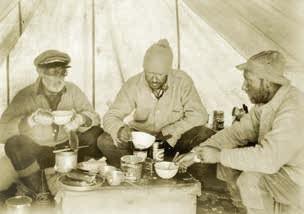


The six mountaineers successfully scaled Mount Logan under extreme conditions, and all returned alive. Careful planning, teamwork
and indomitable grit underscored this exceptional achievement, long before satellite phones, high-tech gear and Gore-Tex. Mack Laing’s contributions at the “tail of the kite” as naturalist and cinematographer are notable, too, and later put him on a path to becoming a dedicated conservationist who stalked animals with a camera rather than a rifle. Hughes explores this evolution in the afterword. Laing’s legacy lives on in Comox, where his seaside property is now preserved as Mack Laing Nature Park. 9781553806806
Othe book is dedicated to richard mackie, author of the definitive biography on Hamilton Mack Laing, Hunter-Naturalist (Sono Nis, 1986), and to the late Ron Hatch, publisher at Ronsdale Press, who encouraged Trevor Marc Hughes in his writing projects.

Mark Forsythe is author/co-author of four books and a former host of CBC Radio’s BC Almanac
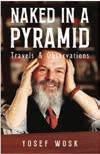


From ReLit Prize winner and Journey Prize finalist comes a salacious and gritty noir mystery where the characters slip between earthly and paranormal domains like silk off a mannequin.The stories in Carthaginian Peace are centred in the domestic and everyday. They follow youngish lovers and domestic partners attempting to find a cure for a cosmic loneliness in an unstable society.
STORIES | 160 PAGES | $18
NOVEL | 352 PAGES | $22.95


coming
this fall...
This debut poetry collection from Giller nominated novelist Annette Lapointe explores the gothic anxieties and bodily discomforts of constant travel.
POETRY | 96 PAGES | $18 CAN
This is not work about the privileged and entitled, but the trapped wage-earners and broken labourers that make the world of the privileged possible.
Naked in a Pyramid: Travels & Observations
YOSEf W OSK
ARON Ch AP m AN & S I m ON K EN d ALL
Real Enough tells the story of the Vancouver band, Doug & the Slugs. From bar band to gold record holders, the Slugs garnered a loyal fan base, charming audiences from Vancouver to New York. Illustrated.

$25.00 | 978-1-77214-221-1 | O CTO b ER
Viewing the world through the lens of psychogeography, Yosef Wosk’s deeply inquiring mind takes us on trips to both poles, the Great Pyramid of Giza, and many places in between.
$22.00 | 978-1-77214-220-4 | O CTO b ER
courtesy : library and archives canada courtesy whyte museum of the canadian rockies v 14 acop 472 whyte museum of the canadian rockies , v 14 acop 553 ??????? /GRAHAM/????
An Artist's Sketchbook Journal
Vicky Earle
• 9781988242484 $24.95 pb Midtown Press
• 9781988242491 $29.95 hc Midtown Press
With a keen eye, Vancouver artist Vicky Earle captures the flora and fauna that exist in green spaces from urban parks to your own backyard. Her observations of the natural world are captured in stunning colour images with fascinating notes about each bird, animal, insect, flower and leaf.

The complete roads and trails guide to Canada's Waterfalls Park - 7th Edition Roland Neave 9780968193235 $29.95 Wells Gray Tours


Updated and expanded with proceeds from all book sales going to support park projects such as trail maintenance and staff to enhance public accessibility and enjoyment of this national treasure.

TALES OF THE KVR
The Kettle Valley Railway
Remembered
Barrie Sanford 9780973560237 $21.95 pb Brookmere Books
Walk it, ride it, hike it - then explore the history of the KVR with this book. Drawing largely from his interviews with railroaders over the past 50+ years and his own research, Sanford presents fresh stories and photographs to give the Kettle Valley Railway its due as a product of a generation of wild west BC adventurers.

Common MAMMALS of the Northwest

J. Duane Sept 9780995226647 $14.95 pb Calypso
Common WILDFLOWERS of the Northwest
J. Duane Sept 9780973981964 $14.95 pb Calypso
Also available in this series: Common Mushrooms, Medicinal Mushrooms, Edible & Medicinal Plants of the Northwest, Animal Tracks & Signs, Common Trees and more - see them all at your local bookstore!
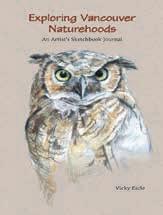
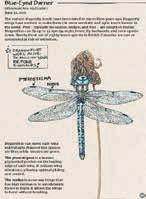
with Phil Rowley & Friends
Phil Rowley 9781777876418 $29.95 OP Media Group
This is the summer to take to the lakes! This multi-award winning fly fisher, writer, trainer and member of the Canadian Fly-Fishing Championships team shares his knowledge of fly tying and patterns for stillwater fishing - a must have for avid anglers

Let's Go Biking
VANCOUVER ISLAND including the GULF ISLANDS and the SUNSHINE COAST
Colleen MacDonald 9781775308164 $22.95 Let's Go Biking

ALSO BY COLLEEN MACDONALD: Let's Go Biking


OKANAGAN and Beyond
9781775308126 $19.95
9781775308102 $24.95
Complete your Whitewater Cooks library...
•Whitewater Cooks Pure, Simple & Real... 9781552858714 $29.95

•Whitewater Cooks at Home 9780981142401 $32.95


•Whitewater Cooks with Friends 9780981142418 $34.95

•Whitewater Cooks with Passion 9780981142425 $34.95
•Whitewater Cooks More Beautiful Food 9780981142432 $34.95


•Whitewater Cooks Together Again 9780981142449 $36.95




G.M. Johnson Maps 9781774492895 $21.95
Keep this map book in your car - and also find GM Johnson fold-out maps for your next trip - trusted travel companions no matter where you go...
Alaska cruising? You'll want this: Inside Passage/Haida Gwaii/South East Alaska Cruise Map & Guide 9781770687295 $9.95 fold-out map
BACK IN PRINT BY POPULAR DEMAND! BRITISH COLUMBIA LULLABY Lynn McCarron 9780991946389 $14.95 Baby Lullaby Souvenirs
This lovely, mega-selling portrait of BC highlights the various regions from forests to vineyards to the Pacific Ocean. The text is a gentle lullaby for the very young. A wonderful gift for locals and visitors alike. Find it in bookstores, specialy shops and in the BC Ferries gift shop.
theatrical producer, David Merrick
BY JOHN MOOREFor obvious reasons most murder mysteries are long on terror and short on humour, other than the deadpan gallows variety exemplified by old Raymond Chandler novels. There have been novels, TV series and films featuring witty or comical detectives and even amusing killers (think of the film Clue, based on the board game; the play Sleuth and its original film adaptation; the novel American Psycho and its film version; and Quentin Tarantino’s Pulp Fiction; etc.) but they tend to satirize familiar situations of the genre so broadly that they end up in Parody (next door to Purgatory on Google Maps).
It’s rare to find a novel like Scandal at the Savoy that can maintain suspense and genuine interest in the characters while delivering laugh-outloud moments every four or five pages.
Like the first novel in this series, Death at the Savoy (D&M, 2022), this too is set in the prestigious Savoy Hotel in England during the “Swinging Sixties.” The story brilliantly evokes the period when A-list celebrities and international politicians, not just pop stars, still needed the validation of being “seen” in London, not B-List burgs like New York or Los Angeles. Priscilla Tempest is a young Canadian woman in charge of public relations for the grande dame of London hostelries. Saddled with a moniker more appropriate to the heroine of a bodice-ripping novel set in a faux-historical England, (another bit of authorial tongue-incheek), Priscilla becomes a real damsel in distress when her already demanding job is complicated by the murder of a showgirl appearing in the Savoy’s cabaret headlined by aging British film siren, Diana Dors
Younger readers may have to redline their search engines looking up all the Sixties’ stars who make cameo and walk-on appearances, but the history

lesson will be rewarding. Those who remember the Sixties will cackle with satisfaction at the fictional resurrection of so many global celebrities whose careers proved it’s possible to be famous for more than fifteen minutes.
Among them is Canada’s youthful bachelor Prime Minister, Pierre Elliott Trudeau, who sweeps Priscilla out of a star-studded Savoy cocktail reception and out of her Mary Quant mini-dress for a five-star one-night stand.

For any Savoy employee, creeping out of a guest’s suite early in the morning is a career-ending move, but unemployment quickly becomes the least of Priscilla’s worries when the strangled corpse of showgirl Skye Kane is discovered in a dressing room at the hotel. Priscilla informs Scotland Yard detectives that during the party, in the Ladies room, she met Skye, who had been slapped and threatened with death by notoriously short-fused
From that plot point, Scandal at the Savoy becomes a deliciously dark farce exposing the sleazy underside of the glamorous Carnaby Street–designed facade London preferred to show to the world. It was a milieu in which celebrity gangsters like the notorious Kray Twins mingled with pop stars, famous actors, Members of Parliament and Commonwealth Prime Ministers with predictable results: blackmail, scandal and what Scotland Yard calls “suspicious deaths.”
As in the film True Romance (another Tarantino film), supporting actors steal this show. The trio of Savoy regulars, playwright Noel Coward and actors Laurence Olivier and John Gielgud, resemble the three witches in Macbeth if their dialogue had been re-written by Oscar Wilde. At the initial cocktail party, one of them refers to the despised Merrick as “the Abominable Showman,” and the quips just keep on coming. Not content to play the role of Chorus in the play, they get stuck right in to aid their friend Priscilla, tailing gangsters through the mean streets of London’s rough East End in Olivier’s Bentley and helping her rescue Diana Dors from the Kray twins. No more spoilers... you’ll have to read the book. O
nanaimo - born prudence emery worked for many years as the press and public relations officer for the Savoy Hotel. She’s now happily mining her memories of that career in collaboration with Ron Base—the Milton, Ontario, novelist who has authored his own series of Sanibel Sunset mystery novels, many set on the Florida islands of Sanibel and Captiva. One of the principal charms of the mystery genre is that murder provides authors and their fictional investigators with a moral pretext to expose the “best” people on their worst behaviour. Prudence Emery, who now lives in Victoria, and Ron Base have come up with a new twist on the old formula that’s five-star all the way to the last morsel.
9781771623452
John Moore has written three novels, a poetry collection, and most recently Rain City: Vancouver Essays (Anvil Press). He lives in Garibaldi Highlands.
Victoria’s Prudence Emery mines her experiences in Swinging Sixties London for a murder mystery that mixes celebrity and terror with non-stop quips.Scandal at the Savoy: A Priscilla Tempest Mystery, Book 2 by Ron Base & Prudence Emery (D&M $19.95) American Prudence Emery in her role as Press and Public Relations Officer at the Savoy Hotel (London), where champagne was a daily rite.
Members of a strange, secret cult being stalked by a man in an animal mask? You, too, could be stalked if you hang out with Naked Defiance, a radical art group that stages subtle but odd public performances in the name of challenging capitalism.
Patrik Sampler ’s new novel is a jumbled mix of narrative tricks, youngadult hijinks and surreal scenarios packaged with a bit of a mystery story about that fellow hiding behind an animal mask. All these occur in a city covered in smog from forest fires, a city suggestive of Sampler’s Vancouverarea domicile.
The narrative tricks start on the first page when Sampler places himself into the story. He says he was engaged by a publisher to edit the manuscript into a book, write an introduction and pose as the author. So, hey, if you
thentic needs.” He says: “We see ourselves as just one kind of animal, with no more rights than any other kind of animal.” Active, not passive, nihilism is good. Mirzoyan adds that his group will bring “delight, mystery, surprise or any combination” to the miserable: “we will be a Heimlich maneuver for the mind.”
In one performance, members arrive at a Wreck Beach locale at precisely the same moment, remove their clothes in precisely the same order, and enter the water identically; then they return to the shore, dress and leave, without speaking to each other. In other per-
formances, a man rides the subway without pants or underwear, and a woman walks a coastal hiking trail wearing nothing but a loincloth and a Noh-style Japanese mask. Members are intrigued by philosopher John Berger’s book Ways of Seeing
In another narrative jest, the Florian author/narrator admits to the publisher in an interjected note that the book is boring but promises things will spice up soon, asking them to please keep reading. In a wink to readers, he says he’s concerned the publisher “might object to what seems to be a
self-consciously ‘postmodern’ move —whatever that means,” because the author and protagonist are the same person. But he’s assured that now it’s old-fashioned, standard practice. Two more interjections are dropped in, the last by a copy editor who takes over from Florian when he’s fired.
Soon the narrative does spice up a little when members on their performances are stalked and chased threateningly by a man wearing animal masks. Who is that masked man? As some members begin to suspect that the stalker is Mirzoyan himself, the group degenerates into bickering and power struggles. Mirzoyan is taken into custody by a sex-obsessed police officer named Xenakis (sharing the name with a real-life European avant-garde composer). Not long after, Mirzoyan is shot to death in a police cell. Florian’s investigation of the death proceeds, but in the end, he takes to another cult, Nazism.
Sampler’s narrative—or that of alleged editor/narrator Florian—takes frequent hairpin turns into tangents about subjects various and sundry. We’re treated, for example, to digressions occasioned by a Soviet-era gas mask found at a military surplus store, and a Roland TR-808 rhythm drum machine, “getting quite trendy among techno freaks.”
don’t like what follows, don’t blame Sampler and don’t shoot the messenger as he “was only doing a job.” And “it’s simply nice to have one’s name in print as an author.” (For the record, Sampler’s first novel, The Ocean Container, appeared in 2017).
The name of the allegedly real author and narrator is presented as Florian Moore, a one-time rock musician with an ordinary McJob. Moore tells the tale of Naked Defiance, “the vaguely Marxist, anti-authoritarian art group” to which he belongs. Apart from sitting around naked at planning meetings, the group, inspired by avant-garde art movements, stages public happenings at the explicit directions of the group’s mysterious and charismatic leader, Ganbold Mirzoyan. Unlikely name? No worries. Moore tells us that all names, events and locations have been altered, including the name Florian Moore. Sampler is clearly infatuated with pseudonyms.
The art group’s purpose is to oppose the “spectacle” of consumer capitalism “in a crumbling environment.”

Mirzoyan, rejecting his own capitalist past, explains Defiance’s strategy to combat “miserabilism—the miserabilism of ecophobia and the cyborg body,” and the “endless production of inau-
The name dropping produces a heavy shower of miscellaneous nouns: obscure and more familiar rock bands, unusual European sports cars, bookstore titles, and writers’ names such as those of Jorge Luis Borges and Michel Houellebecq. The shower of random references may remind the reader of that Wikipedia daily feature that posts various bits of unrelated information from the encyclopedia’s entries.
The book cover describes Naked Defiance as a “turn-of-the-century” group. For those who might think the turn of the century is the early 1900s, this novel may have more limited appeal. But for those born 20 or 35 years ago, the appeal of a story on the slippery nature of truth should be much stronger.
9781554202003
Gene Homel has been a faculty member at universities, colleges, and institutes since 1974.
tA riddle wrapped in a mystery, inside an enigma: Is Patrik Sampler the only writer, or just one of several?
A novel about an eccentric art group that doubles as a murder mystery is authored by two or more people.Naked Defiance: A Comedy of Menace by Patrik Sampler (New Star $19)

A Ribbon of Highway: A Photographic Exploration of Canadian Identity by Taylor Roades

Mr. Mindbomb: EcoHero and Greenpeace Co-founder Bob Hunter: A Life in Stories by Bobbi Hunter
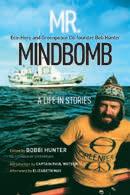
9781771605779
A collection of images depicting Taylor’s poignantly observed, first-person experience.
9781771605793
Featuring over 40 routes, each trip includes a map, places of interest, level of difficulty, and colour photographs.


9781772015089
9781771605618
A collection of personal essays detailing the life of environmental hero and activist Bob Hunter.
9781771606240

Lha yudit’ih (We Always Find a Way): Bringing the Tŝilhqot’in Title Case Home by Chief Roger William & Lorraine Weir
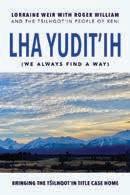


An oral history about the first case in Canada to result in a declaration of Aboriginal Rights and Title to a specific piece of land.

9781772013825

NAKED DEFIANCE A COMEDY OF MENACE PATRIK SAMPLER

Laced with dark social comedy, NAKED DEFIANCE is the story of a turn-of-the-century radical art group, its charismatic leader, and the increasingly disturbing disruptions that befell them.
FICTION :: 978-1-55420-200-3

MARC EDGE
THE POSTMEDIA EFFECT lays bare the changes in news economics that have hollowed out the nation’s newsrooms, undermining not just citizens’ trust in what is reported to them, but the very foundations of a democracy steered by an informed electorate.

CURRENT AFFAIRS :: 978-1-55420-197-6
WWW.NEWSTARBOOKS.COM
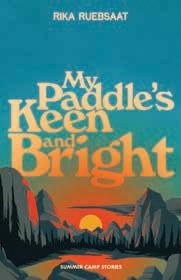
RIKA RUEBSAAT
Camp veterans of all ages reflect on their summers spent away at camp; passionate friendships; crushes on counsellors; the campfires and songs; skinned knees and overcome fears; and the indelible lifelong impressions these experiences have left on them.
MEMOIR :: 978-1-55420-188-4
LUCIA FRANGIONE
A gritty and spiritual story of transformation, forgiveness, accountability, and rebirth, Grazie takes us from Red Deer to Vancouver, from Medicine Hat to Rome, from the Amazon to Andromeda. Both violent and tender, Grazie examines what it means to feel connection to oneself, one’s family, one’s history, one’s culture, and to existence itself.

978-1-77201-508-9 • $21.95 • Fiction
Now Available
Selected Longer Poems
SHARON THESEN
edited by Erín Moure
Refabulations collects and reanimates the longer and serial poems from Sharon Thesen’s œuvre, from her first book in 1980 to today. It is a record of a life in language, created by a dexterous and renegade poet whose mind is ever at work in the poem.

978-1-77201-510-2 • $24.95 • Poetry
Now Available
WANDA JOHN-KEHEWIN

Here is an unflinching look at colonialism’s sickening trail: its ongoingdetriment to the safety and mental health of Indigenous people, its theft of language, and its intergenerational harms
978-1-77201-512-6 • $19.95 • Poetry

Now Available
OTONIYA J. OKOT BITEK

Rife with the paradoxical forces of boredom and intensity, the early days of COVID-19 passed under an inescapable pall. The poems of Song & Dread seek quietude, order, refuge, and space within that shroud. They remind us of community, connectedness, and what is inherently shared.
978-1-77201-516-4 • $18.95 • Poetry
Now Available
is a Vancouver-based, internationally produced, award-winning playwright and actor. She has now published her first novel, Grazie, about a depressed mother, Graziana, who ends up in the hospital after the man who raped and impregnated her, dies in a car crash. Graziana (Grazie for short) needs to heal both physically and emotionally and leaves her eight-year-old daughter, Hazel, in the care of her stepfather (the only father figure she has known) while she makes a pilgrimage to Italy to bike the Via Francigena. To Hazel, Grandpa Herman is “Grumpy,” although she adjusts to him. Herman begins home-schooling the imaginative, dyslexic and troubled Hazel (who also has ADHD), introducing her to a stable home life for the first time in her life, as she struggles with anger at being abandoned by her mother. Both violent and tender, the story covers each of the four main characters in turn: Graziana, Hazel, Herman and Ivan (Hazel’s biological father) through interior mono-
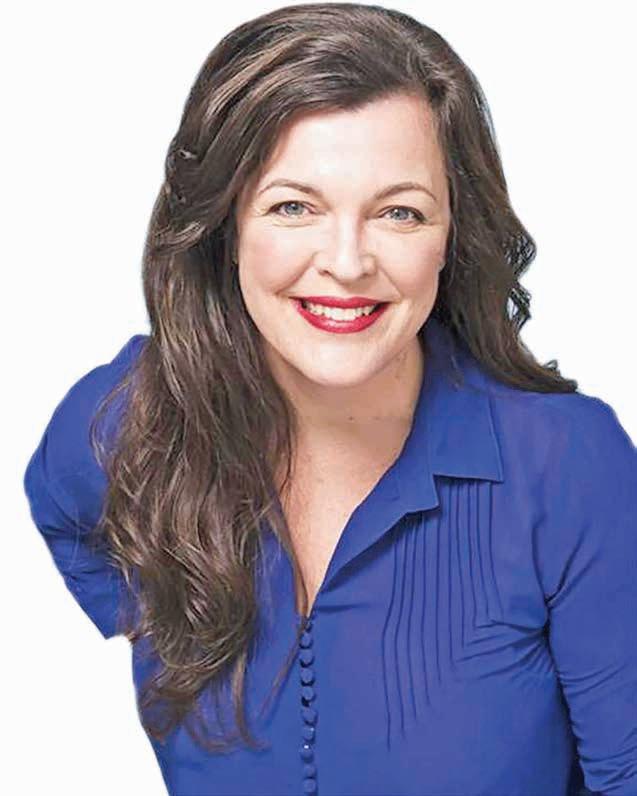
pear trees and raspberries. And a golden retriever. Holy moly, can you imagine having a whole grocery store in your front yard? I’d be like plop Grump’s plop, yum Grump’s yum, m-rg-mouth-is-full-erv cherriezzz! Hrrr yummm! I like dogs. I wanna dog. I already know that this dog, whose name is Oola, is going to love playing with me. I already know that I am going to have a blanket and Oola is going to be my pillow. And then, get this, we will go to Vancouver and guess what? My mom has a cousin there. Well, it was her mom’s cousin and I don’t know what that means for me except that I guess he’s my old old cousin. His name is Marco. Grumpy says Marco is not going to like me calling him my old old cousin and to just call him Zio Marco. It’s kind of weird to call a total stranger “Zio” (which is “Uncle” in Italian) Marco. Maybe I’ll just call him “Hey.” But I think it is cool that I’m going to meet a real Italian because that is part of my DNA. And besides, Grumpy says Zio Marco is a really good cook and very handsome and charming.
else. Mom can live in the stupid condo of Grumpy’s where she kept her stupid bike. Or she can just keep cycling all the way to Australia! Good luck crossing the ocean, dumb Mom! You can’t just leave a house and then think it’s yours when you come back.
Oh, oh, oh! I have to tell you about my great-grandmother, and by the way, she’s a real great-grandmother because she was my dad’s grandmother and that makes her great. And you know what? She sounds great! She sounds super-duper nice and she must be rich because she lives near Disneyland. And I think everybody who lives in California is a movie star or famous or at least really rich. And I know Americans have guns. I asked my
logues, conversations and, in Ivan’s case, communication with angels. The following excerpt is written from Hazel’s point of view about an upcoming road trip with Grumpy, whom she has now learned to trust.
Iwould say that my whole life was pretty much craptacular until yesterday, when my greatgrandmother wrote a letter and then called. And now we’re going to go on a road trip to Vancouver to see the ocean! I have never ever in my whole life seen the ocean! I want to swim like a mermaid but Grumpy says the water is super-duper cold and I’d get hyperthermos. But guess what? Halfway, we are going to stop in a place called Kelowna, which is by some real big lakes in the mountains and it’s really pretty and I have an auntie and uncle there. Grumpy says it gets hot in Kelowna and I could maybe go in the water there, so I should pack a bathing suit.
Yeah, just in one day, suddenly, I have all these family people! I was going to say “not my real auntie and uncle” because it’s Grumpy’s family, but I’ve decided that Grumpy’s family is my family, and they don’t seem to mind, so I now have an uncle and an aunt and they have a big yard with cherry trees and apple trees and peach trees and
And we have to go on our Vancouver trip right away because Grumpy says my mom is going to be back from Italy in two and a half weeks! And we need to be home when she gets back. When I think of this, of Mom coming home, of seeing her ... it’s like my brain is a banana. It goes all mushy and yellow and squirts out sideways — blah. It’s like when I think of my mom, I blink a lot with my eyes. Blink blink blinkedy blink.
I’ve been wondering if I’m going to hug her and there’s no way I’m going to. Not that I’m mean but she has to learn that you can’t just hug a kid if you’re going to leave your own girl for a year.
Phone calls and presents don’t really count. Like I said, Mom can suck an egg.
Grumpy says that he will move out of her room so that she can have her room back and he will go back to his condo down the street. But I think too bad, it’s Grumpy’s room now. Who is going to make me breakfast and do math? (We always do math first while our mind is fresh, says Grumpy.) Mom can go live somewhere
great-grandmother if she was going to bring a gun and she said no. She would leave it at home. (Which means my greatgrandmother HAS A GUN!) This may sound cool to boys at my school, or something like that, but if you think about it, it’s really freaking weird and also scary that such an old lady has a gun because, for one, old ladies don’t see very well.
She is going to take an airplane to Vancouver, and we are going to drive and meet her there. I’ve never in my whole life had someone that wanted to meet me before. Mostly people meet me and then they wish they didn’t. Because I am a “handful,” Grumpy says. And I always think that’s weird because a handful isn’t much. It can curl up, like a tiny pet, like a hedgehog, and you can have it in your hand or carry it in your pocket. To me, a handful sounds super easy and very cute, but I know that’s not what he means. When I go see Uncle Eddie and Auntie Connie and all the cousins there, they are used to being around handfuls so they think I fit right in.
I hope my great-grandmother doesn’t think I’m a handful in a bad way but in a good way. Especially because she’s coming on an airplane. I hope she’s not disappointed. I’m glad I have my new yellow pants to wear. They are impressive and they don’t have holes yet. I get holes on my knees because I am always pretending and lots of times that involves being an animal. I will also have to not be a handful for Uncle David and Auntie Cathy and Zio Marco. They’ve never met me. The good thing about this is: as far as they know, I’m a perfectly normal girl.
9781772015089
In an excerpt from Lucia Frangione’s novel, Grazie, Hazel, an imaginative and troubled eight-year-old with ADHD, takes a road trip to Vancouver with her conservative but trusted, Grandpa Herman.Actor and playwright Lucia Frangione has had twenty-eight plays produced.
 BY JANET NICOL
BY JANET NICOL
The blue-eyed-darner is a magical dragonfly with blue and white colouring, but did you know this four-winged insect existed 70 million years before dinosaurs?
The dragonfly is just one of more than 130 images captured by author-illustrator Vicky Earle in Exploring Vancouver Naturehoods: An Artist’s Sketchbook Journal A visual feast of west coast wildlife and plants, Earle used graphite, ink and watercolours, annotating each sketch with informative, playful and sometimes quirky text. At the sketchbook’s end, Earle offers helpful tips for those interested in keeping their own nature journal. She is the perfect guide, being a professional illustrator in the fields of natural science, medicine and botany.
Like most people, Earle slowed down and paid more attention to her surroundings during the height of the COVID-19 pandemic. The sketches for this book were done during that time, from 2020 to 2022. Her invitation to the reader to make a “green date” and head outdoors with a sketchbook in the wake of the lockdowns will likely find a receptive audience. “The book grew from a desire to help people connect more meaningfully with nature,” Earle writes. She also contends that people’s health and well-being improve around nature, and the goal of environmental protection is better served as people learn more about, and connect with, the flora and fauna in their neighbourhoods.
Each sketch is accompanied with the calendar date it was drawn. Sometimes Earle jotted down a brief weather report beside a sketch. She also provides Latin descriptors of animals and plants, interesting scientific facts and her personal observations. While the author’s knowledge may appear intimidating to the novice, she doesn’t see it that way, suggesting, for example, to do additional searches on the internet for assistance with the identification of a bird species.
Still, it does take talent—and a bit of luck—to sketch the tiny male rufous hummingbird and paint in the red and orange colouring along the male bird’s throat. One of Earle’s techniques is to complete a quick drawing in the field and fill in the details at home. She says it’s helpful to take a photograph of the subject with an iPhone or camera for later reference.
It’s not only visual stimuli that nature lovers can tap into; they can listen, too, as Earle does with the hummingbird: “The sound of their buzzing wings always reminds me of miniature helicopters.”
You don’t have to go great distances to find inspiration, Earle writes in her first chapter, “Close to Home.”
She cites the time when a Cooper’s hawk shooed away all the song birds outside her window and took over the space. It gave Earle the opportunity to draw a profile of the large feathery bird, with its sharp-looking eye and black-blue beak, as she safely studied it from inside her home.
The second chapter, “Vancouver Parks,” features treasures found in eleven green spaces, each illustrated with an aerial drawing. For example, Earle’s sketch of Trout Lake, in the heart of the city’s residential east side, is beautifully depicted in a thumbnail landscape with the blue and snow-white mountains in the distance. Along the lake, the author sighted all manner of wildlife, including the American coot, an aquatic bird with blue-green “lobed” feet that reminded her of fishnet stockings.
A shy, bright yellow Wilson’s warbler is known to dart around the rose bushes at Stanley Park. Earle’s advice is to carry binoculars to find similar sightings. Her drawing of the warbler includes a black colouring atop its head and comes with the comment, “he has a toupee!”
Packing a magnifying lens while venturing in open spaces is another tip from the author. At Quilchena Park, Earle found a yellow jelly-like fungus, called “witch’s Butter,” on rotting wood. She also discovered “Angel Wings,” a type of mushroom that looks like cascading oysters along a walking trail at Pacific Spirit Park. The mushrooms are a pure white colour, and so is “old man’s beard,” a feathery vine blanketing trees and shrubs at Everett Crowley Park.
A detailed drawing of the blue-petalled chicory, a flower belonging to the daisy family, was sketched at Deering Island Park. This plant’s roots can be roasted and used as a coffee substitute.
There’s much more of nature’s bounty depicted in this book, from insects to everyday squirrels and racoons to the single leaf of the sycamore maple. Coyotes aren’t mentioned, interestingly enough, given the tensions caused by human encounters with the creatures in Stanley Park in recent years. The author did, however, take a look at the little brown bat by studying these natural pest-controllers (they can eat 600 mosquitos in one hour) at Stanley Park Nature House. She suggests that intrepid readers who want more, can look for bats as they emerge to hunt insects in the early evening at dusk.
Even if bat watching isn’t on your personal radar, Earle offers many other inspiring ideas for every level of artist and nature lover. The information conveyed in her sketchbook promotes a greater awareness of all living things, great and small. For those readers who commit to making green dates with a journal, she offers a great prompt to get started, borrowed from her mentor, naturalist John Muir Laws: “I notice, I wonder and it reminds me of…”

9781988242484
Janet Nicol is a Vancouver-based freelance writer, retired high school teacher and long-time sketchbook enthusiast.

“Snorkelling around Vancouver Island … seriously?” says Sara Ellison in her guide book about the underwater world of the Pacific Northwest. She irreverently admits the chilly waters of coastal BC aren’t top of mind when considering snorkel destination lists (rather, think Hawaii or the Caribbean), but BC has long been a premier scuba diving location. Even Jacques Cousteau knew that. Ellison shares her knowledge of the joys of the affordable alternative to scuba diving in BC in Snorkelling Adventures

9781990776151
Another COVID-19 book, this collection of street photography was started by photojournalist and author Alan Haig-Brown in 2020. Known for his work about the global maritime industry and, closer to home, the Fraser River, Haig-Brown turned to snapping over 100 urban photos while walking nearly every street, alley and path in New Westminster, including the above image of a fly fisher on the Brunette River (which flows through New West on its way to Burnaby Lake). Fly fishing for Haig-Brown, “was never about catching fish; it was always about observing and feeling the river and reaching harmony with the land,” he writes.
9780994817525
In this coming-of-age travelogue, with over 700 watercolour illustrations of plants and animals, coastlines and portraits of people, David Norwell tells of his 1,700-kilometre kayak journey navigating coastal BC from Victoria to Gustavus, Alaska. He started the trip in 2014 at the age of 24 and passed by more than 50,000 islands over several months. Norwell recorded his observations and musings daily in a notebook, writing of the wildlife he encountered, the solitude he experienced, the survival skills he learned and even the meaning of life.




9781772034493


Writing starts midnite Friday of the long weekend and wraps up midnite of the holiday Monday. The winner receives money, publication, and overnight fame!

The entries are judged by a panel of writers and editors, which announces its winning selection in the spring of the following year. The winning novel is then published by Anvil Press.
An offbeat and funny memoir, British Columbiana perfectly captures a millennial trying to figure out her life.


Between the mid-19th century and early 20th century, schooling for Indigenous and non-Indigenous children and youth had distinct yet complementary functions in building BC. Sean Carleton dives deep into different kinds of state schooling for Indigenous and nonIndigenous peoples—public schools, Indian Day Schools, and Indian Residential Schools in Lessons in Legitimacy: Colonialism, Capitalism, and the Rise of State Schooling in British Columbia. Carleton’s book has been shortlisted for the Lieutenant Governor’s Medal for Historical Writing.
9780774868082

OBC BookWorld: What was your focus in writing this book?

Sean Carleton: Lessons in Legitimacy contributes to the important project of truth-telling about Canada’s history of schooling and settler capitalism in the era of reconciliation. The book brings the histories of Indigenous and nonIndigenous schooling, often studied separately, into one analytical frame.
In doing so, Lessons in Legitimacy examines the overlapping roles played by different kinds of state schooling—including Indian Day Schools and Indian Residential Schools as well as public schools—in building British Columbia, first as a British colony and then as Canada’s westernmost province, between 1849 and 1930.
BW: What was education like for Indigenous and non-Indigenous peoples in BC after 1849?
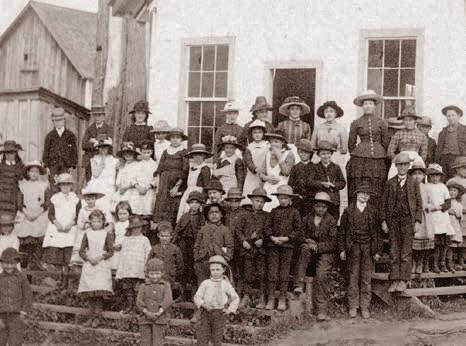
SC: The book shows that government control over schooling was neither predetermined nor straightforwardly imposed. Instead, it offers a long view of the development of state-supported schooling as a struggle and negotiated compromise. Colonial officials in the 1850s and 1860s promoted colonization by building roads and bridges and establishing police forces and courthouses, but they also grudgingly agreed
to assist schooling efforts in limited ways, especially for labouring classes, to appease disgruntled settlers. As more working-class families moved to BC, many parents lobbied the government to fund nondenominational schooling. Unable to afford private schools, they eventually ceded authority over education to the provincial government by the early 1900s. At the same time, the federal government, responsible for “Indian” education, supported the expansion of missionary schooling for Indigenous peoples and collaborated with churches to create new day and residential schools focused on coercive assimilation. By 1930, schooling in BC shifted from mostly ad hoc and voluntary operations to compulsory state-controlled institutions.
BW: Can you give an example of how education was used to shape BC?
SC: Different kinds of state schooling shared the goal of imparting key lessons in legitimacy: the formal and informal teachings that justified the colonial project and normalized the unequal social relations of settler capitalism as commonsensical. Students got lessons in everything from history and civics to home economics and calisthenics in ways that built their character and taught them to take up and accept unequal roles in the emerging social order. Schooling not only preserved social order in the colonies, it actively helped produce—and legitimate—that order. Schools, for both Indigenous and non-Indigenous students, thus served as important laboratories for learning colonial legitimacy.
BW: How does understanding the history of education in BC help us in furthering reconciliation?

SC: The Truth and Reconciliation Commission was clear: without truth there can be no justice, healing or genuine reconciliation. Building on the work of the TRC, Lessons in Legitimacy shows how truth-telling about the past can help strengthen Indigenous-settler relations in the present and facilitate meaningful reconciliation for the future.
BW: What else do we need to know about Lessons in Legitimacy?
SC: I am donating all book royalties to the Indian Residential School Survivors Society, which is based in North Vancouver: www.irsss.ca
The
“An excellent debut. ”
— ANDRÉ FORGET , author of In the City of Pigs
“Teed captures the anxiety and irritation of everyday life with wit and talent. ”
— FAWN PARKER , author of What We Both Know
omisof followstyle, it periellipsis)
Amaster of recursive lines that double back or meld dissimilar ideas like Lao-tzu’s maxim, “The Tao that can be known is not the eternal Tao,” Robert Bringhurst is a serious poet, not for triflers. Read him patiently though, and his ideas evolve.

The old Celtic bards—an order of shamanic Druids themselves—worked much the same way, employing craft as the deeper gears from which poetry and a metaphysics arose capable of expressing what rocks in the rain, or ancient trees have to tell us. As Bringhurst attests in “Language Poem”—an opening series of ten meditations sharing one title—languages live “in the forest of meanings,” and “Atoms, molecules / cells, even subatomic particles / dance in their own language.”
Bringhurst’s first line here addresses stillness: “The heron has practiced his silence longer / than time has been time.” As expected, there’s ambiguity: “together with meaning there has to be / pointing at meaning.” We are given pointers—mathematic, arts, music and grammar—and the requirements of a shared language are noted; what speaker and auditor must bring; the necessary bedrock, the roots and branches of sounds that, “reach around corners and work in the dark.” Like Taoist nature wisdom, “Everything speaks for itself in this world / and everything rests in what is unspoken.”
Eco-linguistics has been an ongoing concern of Bringhurst’s. “Just suppose the roots of language are prehuman / premammalian, prevertebrate—or preorganic, maybe,” he suggests, although the terms of the conversation aren’t rigid. “Go down the well of words until there are no words / Go down until there are no sounds or signs.” This is a poet who engages with the deep aquifers of consciousness—what Indigenous Australians call “the beginning of the world”—pointing us toward the mystic, to “the one-armed man / who hears within his heart / the sound of clapping.” There’s a familiar Zen koan in there, tingling among the snarled quarks, morphemes, chromosomes; the jags of a dreamtime he invokes where language, like Gaia, can arise as a form of sentience.
Does it matter? Indeed. Confucius, when asked what he’d do first if he were given the reigns of State, replied, “to correct language.” For millennia, Chinese civilization—currently angling for renewed global leadership—has revered this “Rectification of Names.” The Master, as he’s known in China, taught: “If language is not correct / Then what is said is not what is meant / Then what ought to be done remains undone.…Hence there must be no arbitrariness in what is said / This matters above everything.”
Orobert bringhurst ’ s work always has philosophical groundings—European, East Asian, Turtle Island eco-inflected. The result here is a phenomenology of meaning where one line can sound like Saraha, the cryptic 8th century Bengali poet; then in another like bluesman Ray Charles, crying, “every meaning / needs a place to go … a place / without a name.” It’s a long soliloquy, all this talk on mind and meaning, that’s rich in the observation of local flora and fauna as well. When he says, “That, I saw the flicker, then the sharp-shin [hawk], say, is roughly how it is” it
makes sense. And wrapping up, when he echoes John Lennon, declaiming, “There is nothing to do that is not being done / nothing to say that is not being said / and so much, so much, that is neither,” that’s alright too. Music, I think, is integral to Bringhurst’s sense of pace. William Blake intended everything he wrote to be sung. Roy Rogers, the sweetest cowboy singer there ever was, believed no performance is complete without a hymn. In 2014, Bringhurst collaborated with partner Jan Zwicky in replacing seven lost sermon texts by a Spanish Jesuit for a work commissioned from Joseph Haydn in 1785, on the seven last words of Christ: “for they know not what they do.”
Taking as their theme “the crucifixion of the earth, not of the redeemer,” each poet wrote “three and a half of the seven interludes required.” Bringhurst’s half proposes, “when you die you go to earth / You go to earth. And when the earth dies, heaven dies / It dies. Hell is the absence of heaven and earth.” Here’s that obligatory hymn, a call to mindfulness for grown-ups, Haydn’s score, Opus 51, included.
There’s a lovely memorial to P.K. Page, and “The
Well,” part of which feels like a Rumpelstiltskin nursery rhyme, and “Stopping By,” a profound reflection on ownership, love, and an older religion that listened to “Douglas-firs / the northern toads and black-tailed deer.”
“The Ridge,” a 65-page poem, shapes the book’s backbone. Bringhurst lives on an island, and he traces its natural history with scientific éclat, vaulting us back to beginnings with a disquisition on its chapels of remaining old-growth conifers, geology, trails and the community-manufactured road in contrast. Despite recurrent fires and human incompetence, the giant trees still work here with unpatterned awareness, growing and collapsing in a fashion that Hopi shamans understood as a cyclical need for disintegration and regeneration. A darkening vision grows, however; we “embezzle whole mountains,” introduce foreign species and destructive pathogens like white pine blister rust; there’s open-net pen salmon farming nearby; and the destructive burning of billions of cords of wood and oil—“Playing with fire / is what humanity does,” he writes. “We are … inching the blue / planet out of the green lap of heaven.”
If there’s poetry in this estranged, impending ecocide, consider: “There is nothing you can do with it —except / what you can always do with knowledge / and with beauty: you can cradle them / like water in your body and your mind / and let them hold you also—” We’ll need that tough love “aboard the deathboat on its rough / and brief last ride,” he intimates. Still, our beloved sun, “the only one / there is that is the sun,” will play its role. Cue the shamans. Cue Haydn’s Opus 51.
9781990776250
Poet, author, watershed conservation activist, Trevor Carolan is professor emeritus of English at University of the Fraser Valley.
Trevor Carolan relates Robert Bringhurst to ancient Chinese masters, Celtic bards, a Bengali poet, William Blake, Roy Rogers, Ray Charles and John Lennon.The Ridge by Robert Bringhurst (Harbour Publishing $22.95) Robert Bringhurst
Five centuries after his death in 1616, William Shakespeare is widely regarded as the most influential writer in the English language. His plays continue to be staged around the world, and heavily studied in schools and universities, as much for Shakespeare’s writing as to broaden perspectives on humanity.
Lisa Dickson, a professor in the English Department at the University of Northern BC, takes Shakespeare a step further in her classroom. She says studying Shakespeare “is an orientation toward the future, a belief in our capacity as human beings to know and to transform ourselves and the world, and a commitment to be moved toward ethical action grounded in love, empathy and an acceptance of difference, difficulty and complexity.”
A tall order, yet all is explained in Dickson’s book Shakespeare’s Guide to Hope, Life, and Learning —coauthored with two other Shakespeare lovers, Shannon Murray and Jessica Riddell—which she discusses in the following interview.
BC BookWorld: When did Shakespeare’s work first make an impact on you?
Lisa Dickson: I fell in love with Shakespeare at the Stratford Festival in 1986, in the middle of Act 2 of Hamlet, precisely at the moment when Brent Carver [the actor playing Hamlet] said: “Remorseless, lecherous, treacherous, kindless villain! O VENGEANCE!” In that moment, between that shout launched to the rafters and its ironic, self-deprecating landing—“O, what an ass am I”—I knew that I wanted to live there forever. I switched my major the next day and have never looked back.

BCBW: What kind of book is this? Is it about Shakespeare’s work or more about what students (and people in general) can learn from Shakespeare’s writing?
LD: This book is a lot of things. For students, for instance, it’s an invitation to open
lots of different kinds of doors into the plays. Each essay offers tools that can bring you into deeper relationship with the play. But the book is more about why art and literature and teaching and learning are crucially important to us here and now. Shakespeare’s works are a place where we can have those conversations, because, not only does he have those conversations in the plays, the theatre gives us a model for how to have those conversations in generative, generous ways. We walk you through an experience of four popular plays with those principles in mind. You don’t have to be an academic to enjoy the book. We’re all learners,
and the book is for learners, that is, anyone with curiosity and an interest in Shakespeare or, indeed, the question of how we build hopeful, empathetic and loving spaces where we can learn from each other.
BCBW: What is the difference between “critical” hope and ordinary hope?
LD: Critical hope is an orientation toward the world, a belief about the world and a way of moving and acting in the world. It is an orientation toward the future, a belief in our capacity as human beings to know and to transform ourselves and the world, and a commitment to be moved toward ethical action grounded in love, empathy and an acceptance of difference, difficulty and complexity. It is “critical” in the sense that it brings to this ethical endeavour an awareness of complex contexts—historical, political, social, artistic, etc.—and a sensitivity to the messiness and “wickedness” of any process of transformation that is inclusive of diverse experiences, needs, perspectives and complicating contexts. So, this is not an airy concept. It’s not about hoping for a particular outcome, as in the more usual sense of the word, but is a means of opening up the possibility of transformation itself. We have two mottos. One is from Ira Shor [a leading exponent of critical pedagogy], who speaks of “the hopeful challenging the actual in the name of the possible.” The other is from John D. Caputo [American philosopher], who tells us that “We never are what we are; something different is always possible.” We are going into the future, and if we are to have a future at all, we must go together. Critical hope is a means of going together.
BCBW: Why did you choose the four plays you did for this book (King Lear, As You Like It, Henry V and Hamlet)?
LD: On a more technical level, we wanted to test our critical principles in a range of genres, and these plays cover territories of tragedy, history and comedy. On a practical level, because this book is aimed at a more general audience, we chose plays that are more popular. It’s not necessary to have read the plays or to have a detailed understanding of them in order to read the book, but these four plays loom pretty large in the cultural imagination, so they are a good place to begin. On a more philosophical level, these plays are each in their own ways engaged in conversations about hope, empathy and love, and all of the wicked questions and challenges that arise when diverse people engage each other, sometimes more or less hospitably, in debates. And we chose these plays because we love them— their beauty and complexity and nuance and profound humanity.
Lisa Dickson explains how four plays by Shakespeare can help us discover why art, literature and learning are crucial in living our own lives.Shakespeare’s Guide to Hope, Life, and Learning by Lisa Dickson, Shannon Murray and Jessica Riddell (UTP $29.95) tLisa Dickson is a professor of English specializing in Renaissance literature and literary theory.
BCBW: Do you have a favourite Shakespeare play?


LD: Well, Hamlet changed my life and I never get tired of poring over it. It’s a new thing in every change of the light. But I love Henry V, too, for all the ways that it challenges us to think critically about how history is made, how heroes are made, how we buy into—and resist the allure of—brilliant rhetoric. It’s also a favourite because of the way that it relentlessly invites us into it, demanding that we use our “imaginary powers” to make a whole kingdom out of three guys and a hat. We have tremendous power and responsibility, we wondrous
creatures whose imagination allows us to envision entire worlds. How can we embrace that power? What worlds do we want to envision? So, I love those two very, very much. A close second is all of them

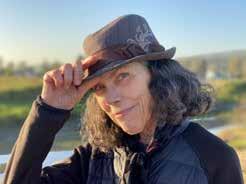
BCBW: Has your interpretation of Shakespeare’s work changed over time?
LD: Yes, of course. I would hope that my vision has deepened and broadened since my youth. My love has only grown, keeping pace with my expanded sense of how complex and messy Shakespeare is. I’ve grown much less interested in being right about Shakespeare, and way more interested in the opportunities he gives us to explore and rattle and open all the trap doors and revel in the weirdness and the contradiction and the utterly inexhaustible possibility of art. I’m much more interested in diving in with learners and way less interested in being the expert. If there’s one thing Shakespeare shows us, it’s that anybody who thinks they’ve got “The Answer” doesn’t.
BCBW: Anything else you would like to add?
LD: Only that this book is a true labour of love. We began as colleagues and became the best of friends in the writing of this book. We made each other brave, since it takes some bravery to tell academia that it is possible to be simultaneously rigorous and joyful, carefully critical and delighted. We hope that our readers will take the invitation we offer to break open, to embrace messiness and conversation and their “imaginary powers” to envision, as Paulo Freire [Brazilian educator and philosopher] says, “the creation of a world in which it will be easier to love.”
9781487570514
ISBN: 978-1-7781603-3-2 $20




ISBN: 978-1-7781603-2-5 $20





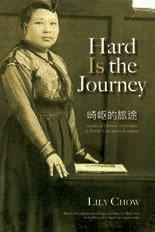





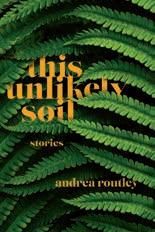

Young news junkies often get their first information fix from newspapers and news on social media.
Some of them, like Raina Delisle, the author of Breaking News: Why Media Matters, go on to adult careers in journalism. Whether or not they make a career in journalism, kids who get addicted to the news early in life mostly go on to adult lives as prodigious and, hopefully, sophisticated consumers of media. This is good news for democracy, so dependent on voters having access to the necessary information for choosing their political leaders.
Delisle targets kids in the crucial years between 9 and 12. Lighthearted in tone and beautifully accompanied with cartoons by awardwinning Vancouver Island illustrator Julie McLaughlin, the book includes a thumbnail history of news media down the ages and a survey of the 21st century’s rapidly changing and often problematic media landscape, complete with its dying newspapers, trolls, cyberbullies and fake news. Along the way, Delisle introduces her readers to pioneers of journalism and to tools and resources they can use to make their adventures in media safer and more productive.
One of the many pioneers Delisle covers is Elizabeth Cochrane , a young woman coming of age in America in the late 1880s. Cochrane, 18 years old and outraged by an editorial in the Pittsburgh Dispatch that insisted women were obliged to stay home and tend the house and the children, wrote a stinging rebuke to this sexist view in a letter to the editor. The paper’s editor was so impressed that he hired Cochrane. Using the pen name “Nelly Bly,” Cochrane went on to an illustrious career as an investigative reporter. In one instance, Cochrane reported on the abuses found in the punitive “mental asylums” of the day by going underground posing as a patient. For another ambitious story, Cochrane persuaded her editor to fund her round-theworld travel in an attempt to navigate the planet in less than the 80 days claimed for the trip in the popular Jules Verne novel. She completed the journey in 72 days. Bly’s motto was, “If you want to do it, you can do it,” and Delisle clearly means for her young readers to adopt that motto for themselves.
Delisle’s quick survey of the history of news and its propa-

gation, from petroglyphs to pixels, is a brisk, entertaining romp. She spends some time on the evolution of news technology from the first known newspapers—the Acta Diurna or “daily events,” handwritten sheets circulated during the heyday of the Roman Empire—to the creation of moveable type in the Chinese and European Middle Ages, as well as the decisive technological leap achieved when Friedrich Koenig linked an early steam engine to a printing press—at a single stroke quadrupling the speed and volume possible with earlier hand
presses modelled on Gutenberg’s invention from the middle of the 1400s.
As soon as you have a press, the issue of freedom of expression is posed, and that has been a fraught and contested issue ever since. Kings, aristocrats, priests, Inquisitors and prelates all had an interest in shutting up critics and restricting the limits of allowable expression. This impulse to censor grew stronger with every technological improvement. According to Reporters Without Borders in its 2022 World Press Freedom Index, which assesses 180 countries and territories, journalists face not only censorship from official sources but also chaotic torrents of misinformation and propaganda from official and unofficial sources.
The Index notes: “Within democratic societies, divisions are growing as a result of the spread of opinion media following the ‘Fox News model’ and the spread of disinformation circuits that are amplified by the way social media functions. At the international level, democracies are being weakened by the asymmetry between open societies and despotic regimes that control their media and online platforms while waging propaganda wars against democracies. Polarisation on these two levels is fuelling increased tension.”
The first law guaranteeing freedom of the press was passed in Sweden in 1766, and the existence of papers, publishers, and writers willing to speak truth to power has remained one of the defining characteristics of a working democracy. At its best, a working journalism sector can act as Socrates’ “gadfly of the state,” calling out abuses of power and informing citizens so they can more effectively engage in self-rule. Delisle clearly values this role, and her book invites young readers to become critical thinkers about the torrents of data that engulf them in the 21st century, and to consider themselves as working journalists, both now and in the future.
But Delisle is realistic about the challenges young people will face in any attempt to master the current media universe: far too much content, fake news, silos of computer-driven agreement and mutual reinforcement, trolls, sensationalism, clickbait and censorship. Although recognizing with commendable frankness all the reasons for despair about journalism’s future, (and humanity’s, for that matter), Delisle ends her charming book on an optimistic note with two aspirational chapters titled “Saving Journalism” and “Become a News Hound.” As bonus content, she adds a list of resources for the aspiring young news junkie, including biographies of fearless feminist journalists and news sources purpose-built for kids, including the intriguing MediaWise Teen Fact Checking Network: www.poynter.org/mediawise/programs/tfcn/
All in all, this book would be a great gift for any bright and aspiring young journalist, or for any young person who wants to be a responsible adult while navigating the turbulent waters of the current media world.
9781459826564

Thirteen-year-old Jay isn’t enjoying traipsing around the forest, minding his little preschooler sister while his father searches for Sasquatch in Gail Anderson-Dargatz’s fiction for middle school readers, Bigfoot Crossing. Looking for a mythical creature isn’t Jay’s idea of fun — and he misses his mother too. Then things get scary in the forest when a Sasquatch begins following them, and Jay is called upon to save his sister and dad.
In addition to her twelve middle school titles, Anderson-Dargatz has written seven books for adults including her first novel, The Cure for Death by Lightning (Knopf, 1996), which won the Ethel Wilson Fiction Prize, the Vancity Book Prize and the Betty Trask Prize, and was shortlisted for the 1996 Giller Prize and the Chapters/Books in Canada First Novel Award.

BC BookWorld: What appealed to you about Sasquatch?
Gail Anderson-Dargatz : Bigfoot or Sasquatch lore is part of BC culture. I grew up hearing stories from my parents and others about Sasquatch encounters. My dad was a real mountain man, ranching sheep throughout the Thompson-Shuswap. He told stories of hearing the hoots of a primate-sounding creature, unlike any of the animals he knew so well in the region. But it was a poster I found on a park outhouse that inspired this particular book. It was a spoof of the BC Forest Service bulletins that warn of bear encounters. This one read “BC Forest Service Bulletin. Sasquatch Alert” and offered tips on how to act around a Sasquatch. The joke made me laugh. Immediately, I had my story: a disbelieving kid is dragged on bigfoot hunting trips by his dad, only to run into one himself.
BCBW: Do you think Sasquatch are real?
GA-D: I’m not sure, but I’ve heard too many stories for their existence to be easily dismissed. And there’s fossil evidence that there was once a creature very much like Sasquatch, the Gigantopithecus. The huge nests found in the Pacific Northwest — which look like those built by gorillas, orangutans and chimpanzees — are particularly compelling evidence that they may be out there.
BCBW: Who’s the target audience for Bigfoot Crossing?
GA-D: It’s for middle-grade readers who are reading below grade level. It’s a hilo book: high interest, low vocabulary or reading level. It’s also suitable for reluctant readers or any teen wanting a quick read. In many ways, hi-lo books are more difficult to write than the literary novels I work on. Each word or phrase must be weighed for comprehension. Stories are carefully plotted to be exciting and engaging to draw in struggling readers (and keep them there). And the story must be
clear roadmap of where I’m going with my story. But it’s in the discovery draft that the story tells me where it wants to go. That’s when surprises turn up. For example, Jay’s final solution to saving the day popped up out of nowhere in the discovery draft. I originally had a different ending. I won’t spoil it by revealing either ending, other than to say my final ending was actually in my original inspiration for the story, but I hadn’t noticed it.
easy to understand. That means few characters, no subplots, no flashbacks. Subtext or cultural references must be left out or explained simply. Sentences are no more than fifteen words; paragraphs and chapters are short. The novels themselves are very short.
BCBW: The main character, Jay, has a distinctive—and very teen—voice. How did you develop that?
GA-D: I just listen to my kids and their friends! But, of course, finding that teen voice is more than just paying attention to how kids speak. It’s about getting back inside the teen mindset, understanding what it’s like to be that age and what’s important to them. Most people think writing is about “writing what you know.” But, really, that’s not it at all. Otherwise, I’d write only about middle-aged writers talking to their cats. Instead, we research to understand others and then put ourselves in their shoes. In many ways, writers are actors.
BCBW: The story is fast-paced with
plenty of cliff hangers. Is that something that came naturally to you?
GA-D: I started out as a literary writer where cliffhangers are not the norm. So, when I first started writing hilo, I worked hard at story pacing. I rummaged through the toolboxes of commercial writers to find tools, like thriller structure, that I could use to engage struggling readers and keep them immersed. In fact, this was how I fell in love with thriller structure and started writing thrillers for adults. With Bigfoot Crossing, as with each hi-lo I write, I started with a synopsis to map out that compelling situation and clear story arc. Then I built a chapter outline, before starting the discovery draft. So, I had a very clear idea of where I was going before sitting down to write. Having said that, pacing developed through subsequent drafts, as it always does.
BCBW: There are lots of surprises in the story. Were they all in your outline or did you discover them as you wrote?
GA-D: The chapter outline gives me a
BCBW: What other techniques did you employ for page-turnability?
GA-D: What keeps someone reading is a causal chain — one thing leading to the next — that escalates in intensity towards the climax. So, it’s all about throwing increasingly difficult challenges at the protagonist and, most importantly, having the protagonist act to achieve their goals. While I don’t want to give too much away, I will say that Jay has one main goal in Bigfoot Crossing: find and then save his dad. But I made that difficult by giving him a little sister to protect, a monster in the woods who’s following them, and a second “monster” he didn’t even know was there. It’s all about keeping the reader asking: what will happen next?
9781459834767
Zena Ryder is a BC-based writer currently writing a historical novel about a suffragist who’s committed to an insane asylum during the American Civil War. www.zenafreelancewriter.com
Bigfoot Crossing by Gail Anderson-Dargatz (Orca Currents $10.95)Tom, a teen struggling with his identity, runs away from his non-affirming parents to stay with his “out” uncle. Landing in Vancouver during the 1990 Gay Games, he meets a cast of characters who were prominent in this landmark event and has to decide on the path his future will take: return home to a closeted life or make a new life in Vancouver. $22.95 |
















Ages 8 – 12
BY HEIDI GRECOEleven going on twelve-year-old Leo and his nine-year-old sister, Lizzie, are less than thrilled when their parents tell them they’ll be leaving their condo in Toronto for a visit to their grandfather, who lives off BC’s coast on Heron Island. Recognizable as a stand-in for several of our Gulf Islands, the fictional Heron Island is full of back-to-the-land types, and— shocking as it proves to be for Leo—their grandfather’s home turns out to be a place that doesn’t have any internet connection. Considering that both kids are reliant on Wi-Fi for games and communications, the visit looks as though it could be quite a challenge for them. It doesn’t help that their grandfather seems like such a grumpy person.
On the first morning of their stay, Leo wakes to the sound of a “grumble-huff” and wonders whether it’s an animal or a groaning from within the walls of the nearly hundred-year-old house they’re in. Then, when the sound is accompanied by stomping sounds, Leo concludes that it “could only mean one thing: the grumblehuffing animal was Grandpa himself. Because Grandpa didn’t walk. He stomped.” Of course, as things turn out, we learn that their grandfather has his reasons for this facade.
The brother-and-sister duo have barely landed on the island when their parents decide to leave for greener pastures—in their case, a spa at nearby Porpoise Island. This means the kids will be left behind and will have to learn how to get along with Grandpa.
In some ways, it’s a blessing. Not only does it nudge the kids into getting to know their grandfather better, it frees them of the pigeon holes their between-jobs, tech-professional dad has placed them in. Thanks to a personalitypredictive website, he’s determined that Lizzie is an Adventurer, while Leo feels stuck in the role given him: Auditor. He can’t get very excited by thoughts of spending his life looking over people’s taxes. Yet we get to see that it’s true: Leo is not much of an Adventurer as even the ride on the ferry
makes him nervous. During the hour-long trip, Leo tries “not to think about the deep, dark water churning beneath them … he had once spent several weeks exploring the ocean in a game called Neptune 3: The Deepest Dive, so he knew a thing or two about how incredibly dark and unbearably cold it was down there.”
Lizzie makes friends with a
barn cat while Leo goes through near withdrawal from not being able to access the online games he’s accustomed to playing every day. But then, nearly as soon as the parents depart, a crime hits Heron Island: a stack of bee hives, once the pride of their departed grandmother, disappears during the night. Suddenly the kids find a cause: now they can be detectives!
When a group of apparently well-meaning older friends who call themselves the “Bumblers” arrive, the search party gets serious. The biggest annoyance this crew presents is their overly enthusiastic use of puns, which get “un-bee-lievably” overdone as they discuss ways to look into the “buzz-iness” of the missing hives.
tAfter exploring the homes of several suspects, things get even more complicated as the search broadens. This results in Grandpa and the kids (and Lizzie’s kitten, aptly named Mayhem) needing to go to Porpoise Island themselves.
But after plenty of “bumbling” around, matters get resolved, with a culprit and a motive finally discovered, due in part to two very clever kids who have come to appreciate each other better than before, but who’ve also managed to mellow out Grandpa. Leo even learns that he might not be destined to live such a dull-sounding life as his “Auditor” profile had promised.

Ofor any parent who wishes they could get their child to spend less time in front of a screen, this book could well provide a welcome distraction—but be warned, a number of the facts that help the children solve the mystery are details they’ve gleaned from the games they’ve played and sites they’ve visited online. Many bits of information about bees and beekeeping, as well as details about the traits and habits of cats, get slipped in among events—yet this fastpaced story never feels preachy. Although aimed at middle-grade readers, Vancouverite Rachelle Delaney has written a book that manages to be informative for almost anyone while also being rollicking good fun.

9780735269309
Heidi Greco once spent a memorable holiday on the real Heron Island, which is situated along the Great Barrier Reef off the coast of Queensland, Australia.

For North American teens aged 13–18, two handfuls of days in August, 1990 might seem impossibly remote. If identifiable at all, 1990 itself could be considered prehistory. After all, Britney Spears’ “Baby One More Time” video premiered in 1998, and Rihanna made “Pon de Replay” a phenomenon back in 2005. In 1990, Mark Zuckerberg turned six and the iPhone wasn’t yet a gleam in Steve Jobs’ eye. On the rare occasion that “streaming” appeared, the verb had nothing to do with data transmission.
The year might not register with much impact in Queer history either. This term’s popular use began some two decades past Stonewall, eight years after “AIDS” entered the lexicon, and a decade and a half before Canada’s Civil Marriage Act.

Published as a title in Lorimer’s “Children & Teens” catalogue, One Summer in Vancouver makes a heartfelt—and entertainingly persuasive— case for YA readers to deepen their historical knowledge. There’s also a bonus for the quiz-oriented pupil of an imaginary high school’s Queer History 101 class. Question: Name a significant societal moment between the onset of the AIDS pandemic and homosexual marriage in Canada. Answer: Celebration ’90 Gay Games III & Cultural Festival is a perfectly admissible answer.
In particular, for YA readers who identify as LGBTQIA2S+, Tony Correia’s celebratory novel can serve the invaluable function of colourfully filling in a historical blank. And in doing so, One Summer provides not only a rousing account of communal roots but an impor tant message about the active, necessary and fruitful work of visibility. In the case of non-YA readers—aka geezers—the novel might prompt nostalgia for long-gone Vancouver landmarks as well as the sobering realization about how quickly time flies.
For Vancouver’s Tony Correia (author of YA titles Walk This Way and Same Love as well as a memoir, Foodsluts at Doll & Penny’s Cafe), the novel’s core theme is clear. In his “Historical Note,” Correia summarizes One Summer as “a novel about a diverse community demanding a seat at the table.” He implies that without toil and persistence, Celebration ’90 may well have never occurred at all: “They did so by working through their differences to host the world’s largest sporting events in 1990 without financial support from federal and provincial governments, without advertising and without the benefit of the Internet.”
Far from coming across as a dry lec-
ture about the importance of elbow grease and stickwith-it-ness, One Summer focuses on the adventures of a trio of adolescents. Similar to Armistead Maupin ’s Tales of the City (which appeared in book form in 1978), the novel’s primary appeal stems from its likeable, relatable characters. And while One Summer relates coming-of-age experiences under the shadow of AIDS, its cast is neither sombre nor insular. In setting his characters in the midst of a festival of day-throughnight celebration (from a variety of homes and sporting events all over the city to literary readings and night clubs), Correia situates his adolescents in a network of people of all ages and nationalities
who have varied life experiences, political stances and beliefs. In short, between July 28, 1990, when the novel opens, and Sunday, August 12, 1990, at the novel’s epilogue, these kids see and learn a lot. For them, Celebration ’90 is formative.
“If it weren’t for The Village People, I’d still be home in Mississauga, stocking shelves at Safeway,” laments one of the novel’s main characters, Tom, in the first chapter. Not out of the closet— not even sure of his identity—Tom has run away from his non-affirming parents to his “out” Uncle Fred’s place in Vancouver, just as the Gay Games are about to start.
Momentarily disoriented, Tom had been wide-eyed and astounded when he heard The Village People’s “Go West” on the radio in his mom’s car and decided it was a sign to fly across the country without a word to his parents. Later, Tom meets his Uncle Fred’s roommate Gaetan, who cracks, “That’s the power of disco.”

Athletic, popular and eager to be the son his father expected (which is to say heterosexual), Tom delights at hearing himself identified as “questioning.” He intuits he can formulate answers to his own questions only when he’s far from home. Before arriving at his delightfully acerbic uncle’s home in the West End, Tom bumps into Dwayne on the street. A junior Goth (who carries an Anne Rice book like a bible), Dwayne correctly—and bitterly—senses he’s Tom’s opposite: neither popular nor attractive, this A&B Sound clerk is later told he’s a “nobody” (by a fully-grown, American A-lister and gay Republican, who turns out to be the novel’s sole antagonist incapable of rehabilitation). For himself, Dwayne projects a life to come marked by alienation and loneliness.
In the West End, Tom also meets Gina, whose home life with a conventionally minded and devout mother has reached a crisis. Torn between genetic family and chosen family, she understands a momentous decision is hers to make—and soon.
Written in first person, all three characters are engrossing recreations of adolescents—creatures prone (but not limited) to drama, angst, impulsiveness, jealousy and infatuation. Numerous personal quandaries aside, Gina, Tom and Dwayne’s direct exposure to a dizzyingly politicized adult world hints that while their teen eras have been momentous, the trials of adulthood will challenge them further still.
9781459417236
In 1990 Brett Josef Grubisic moved (with his boyfriend, younger sister and best friend) from Victoria, BC, to Japan. He taught English at a Berlitz branch in Tokyo.

In One Summer, a teen questioning his identity runs away from his home in Ontario to Vancouver just as the 1990 Gay Games open.
When travel writer and historian Rick Antonson planned a trip on the Rocky Mountaineer, he initially thought to go solo “as that makes it easier to get into those awkward situations where stories live,” he writes in Train Beyond the Mountains: Journeys on the Rocky Mountaineer (Greystone $34.95). But then he thought that being “on one of the world’s great trains was too special not to share.” Having travelled on a previous train journey with his grandson Riley, Antonson asked the tenyear-old boy to accompany him again. Riley didn’t hesitate, and his fresh way of seeing things is as much a part of this book as Antonson’s historical and geographical insights.

9781771644860
In his seventh decade, poet, fictionist, memoirist and journalist Brian Brett is thinking about mortality as evidenced by his recent collection of poems, To Your Scattered Bodies Go (Exile $24.95). The title, taken from John Donne’s Holy Sonnets, references the afterlife, but many of these new poems are about looking back to celebrate a life lived to its fullest. His advice to others is full of vigour and passion: “I write these words / only for those who know that going too far / is not going far enough.”
9781550968897
The little-known history of 140,000 Chinese workers brought to Europe as non-combatant labour during WWI is the backdrop to Janie Chang ’s fourth historical fiction novel, The Porcelain Moon: A Novel of France, the Great War, and Forbidden Love (William Morrow/HarperCollins $27.99). It’s 1918, and a young Chinese woman, Pauline Deng, runs away from her uncle’s home in Paris to evade an arranged marriage in Shanghai. Pauline

ends up in the home of Camille Roussel, who is planning her own escape from an abusive marriage as well as the end a love affair that can no longer continue. The two get caught up in a dangerous situation that binds them together for life. Vancouver-based Chang is a graduate of SFU’s Writer’s Studio program.
9780063072862
Born in Mexico City in 1947 to an American father and English mother, and raised in Belize for part of her youth, Lolla Devindisch remembers having parrots, turtles and boa constrictor snakes for pets in her memoir, A Dancer’s Pilgrimage (Rainbow $20). It was an idyllic time on her father’s commune until his mental health deteriorated, prompting her mother to flee with her four daughters back to England.

Haunted by the loss of her father, who later died at the age of 46 without ever seeing his children again, Devindisch was drawn to the arts and became a professional dancer. She moved to New York City to meet her late father’s family and dance with the Radio City Ballet Company. She got married and relocated to South Africa, continuing with her dance career. Homesick, Devindisch returned to England but would soon leave again, this time finding a creative and spiritual community, as well as lasting love, on Salt Spring Island.
She argues that the lessons learned from that historical campaign can be used in the current “war” against climate change to reduce the environmental footprint of our food production and distribution. Boyle is a journalist and college instructor who often speaks on how food systems can become more healthy, sustainable and fair.
9781039123663
excitement only a war could provide. Or so I thought,” he recalls in An Accidental Humanitarian: Memoir of an Aid Worker in the Yugoslav Wars (FriesenPress $23). Fowler’s diary-like story details the suffering of civilians caught in the conflict and thousands of displaced persons, as well as being in the middle of the largest (and final) battle— Operation Storm.
9781039130173
9781778160301
“Better pot-luck with Churchill today than humble pie under Hitler tomorrow. Don’t waste food!” reads a World War II poster produced by Britain’s Ministry of Food. The country’s wartime food rationing and other food programs helped win the war, says Vancouver’s Eleanor Boyle in Mobilize Food! Wartime Inspiration for Environmental Victory Today (FriesenPress $26.99).
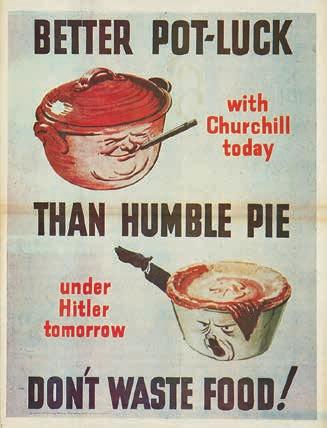
In 1994, aged forty and at loose ends after a broken marriage, Roger Fowler decided to leave the Cotswolds in England for the war-torn region of the former Yugoslavia to work as a truck driver delivering humanitarian relief supplies for the British Red Cross. “I came for the adventure and

There’s rawness and vulnerability in Secwépemc rancher, poet, educator and cultural advisor Garry Gottfriedson ’s latest collection, Bent Back Tongue (Caitlin $20). He tackles colonialism, reconciliation and the church but also sexuality (including fraught masculinity), love, land and family. The 68 poems reveal Gottfriedson’s deep and undeniable honesty “where all things pure and simple / thrive in truth,” that lead to “a sparkle, a small simple sparkle / beaming life / defying death.”
9781773860961

Chasing Rivers: A Whitewater Life by Tamar Glouberman (D&M $26.95)


At UBC in the mid-1960s, Sonia Fenger (later to be known as Rosanna Sonia Hille) was asked to have tea with an elderly couple who employed her boyfriend. Later Sonia learned the employer’s name: Lawren Harris of the Group of Seven (who lived with his wife Bess in Vancouver at the time). That same year, one of her English teachers was the renowned poet Dorothy Livesay, who became a friend, mentor and landlady when she rented Sonia a room for $14 a month. All is told in Rosanna Hille ’s memoir, Swimming in Stories: The River of My Life (self-published $25). Sonia went on to marry, raise a family (including Vancouver composer and singer Veda Hille ), become a textile artist, and work in community and international development.

9781738782505
sewed secret pockets into their petticoats to hide food they snuck from the kitchen, to feed themselves and other starving children, without the priests and nuns knowing. “We found our ways and filled our pockets with what we needed to carry on,” writes Janicki. “We filled our pockets with so much more than food. We filled them with our future.”
9781459833722
…or, to be more precise, “I” is your body, as Tara Teng says in Your Body Is a Revolution: Healing Our Relationships with Our Bodies, Each Other, and the Earth (Dundurn $23.99).
Teng, an embodiment coach, lays out how people have disconnected from themselves as well as the collective of other people and nature (the earth). She offers ways to disengage from this centuries-old, body-based oppression built into our culture or masquerading as religion. As publicity for the book states, “we can take back what society says is too much—too loud, too feminine, too masculine, too gay, too worldly, too unique. Now is the time to journey back to our bodies and to celebrate our whole selves.”
9781459752863
Among the many horrors of Indigenous residential schools was a lack of food and proper nutrition. Indigenous children rarely had enough to eat, as described in Peggy Janicki ’s The Secret Pocket (Orca $21.95) for ages 6–8, with illustrations by Carrielynn Victor

Based on a true story Janicki’s mother told of living in these colonial institutions, a group of girls

Saajin (Sah-jin) Singh loves his name, but on his first day at school, the teacher mistakenly mispronounces it as “Say-jin,” and that’s how everyone else begins to say it. At first, Saajin isn’t sure if he should correct his teacher even though it saddens him. He eventually realizes he should reclaim his name, as told in Kuljinder Kaur Brar’s culture-celebrating, empowering book, My Name is Saajin Singh (Annick $22.95) for ages 4–7, illustrations by Samrath Kaur. Abbotsford-based Brar is an elementary teacher whose son, named Saajin, inspired the story.
9781773217055
In her debut novel, Landscapes (Doubleday $29.95), set in a not-too-distant future of ecological ruin, Vancouverbased Christine Lai creates the world of Penelope, who is archiving an art collection in a crumbling English country house soon to be demolished. Told through diary entries, essays and narrations, this book has been described as a “reinvention of the pastoral and the country house novel.” There’s fear and loss in Lai’s story but also a kind of sanctuary found through the art of old masters and Penelope’s loved ones.
9780385684248
Kuljinder Kaur Brar’s debut book is My Name is Saajin Singh
From Where I Stand by Jody Wilson-Raybould (UBC Press $24.95)

Capturing the Summit: Hamilton Mack Laing and the Mount Logan Expedition of 1925 by Trevor Marc Hughes (Ronsdale Press $24.95)

Having shaken up federal politics when she went from being a senior cabinet minister in Justin Trudeau’s Liberal government to becoming an independent Member of Parliament, Indigenous leader Jody Wilson-Raybould has published a collection of her speeches and lectures from the past ten years. She is forthright in her analysis of Canada’s colonial past and her desire for a new era of recognition and reconciliation.
Ecologist Hamilton Mack Laing endures dust storms, befriends a family of ravens and fearlessly tracks elusive bears in this daring adventure story. In 1925, Laing joined a climbing expedition led by Fred Lambart to conquer Canada’s highest peak, Mount Logan. Laing and Lambart’s diaries give the reader a visceral, tactile and cinematic experience of the north.
Every Little Scrap and Wonder: A Small-Town Childhood by Carla Funk (Greystone $29.95)
Galena Bay Odyssey: Reflections of a Hippie Homesteader by Ellen Schwartz (Heritage House $26.95)

Raised in a comfortable middleclass home in the suburbs of New York City, Ellen Schwartz tells of catching the “back to the land” bug in the 1970s with her husband and moving to a Galena Bay homestead, near Revelstoke, BC for ten years. She examines the ideals of the times as well as the differences between loggers and hippies, and rural dwellers and townsfolk.
Poet Carla Funk grew up in a Mennonite community in Vanderhoof. After publishing five books of poetry, this is her first memoir, a paean to childhood and rural life in British Columbia. Paying tributes to both her church-going mother and her truck-driving father, she uses rich language to create the world that shaped her as a person and writer.
What does it take to be a whitewater raft guide in BC, especially for a woman? Tamar Glouberman reveals all in her memoir of being one of a handful of female guides in a male-dominated business. She encountered sexism but also the rewards of spectacular scenery and natural sights. Eventually the excitement mingled with danger leads to a mid-life crisis.
Sockeye Silver, Saltchuck Blue by Roy Henry Vickers & Robert Budd (Harbour $9.95)
With catchy rhymes married to Roy Henry Vickers signature artwork, this children’s board book is the third instalment in a series that started with Humpback! One Eagle Soaring The concepts of colours are linked to the changing seasons on the West Coast: red tones of huckleberries in summer, silver and red flashes of spawning salmon in fall, grey rain in winter, and the sprouting of green in spring.
In the Slender Margin: The Intimate Strangeness of Death & Dying by Eve Joseph (Anvil Press $21.95)

Award-winning poet Eve Joseph turns to lyrical prose and storytelling to explore the great mystery of death. Throughout, Joseph links her own personal experience with the final act of life (death) from 20 years work she did in a palliative care hospice comforting the grieving and the dying; as well as her stories of losing a much older brother when she was a young girl.
The Survival Guide to British Columbia by Ian Ferguson (Heritage House $19.95)
Having moved to B.C., humorist Ian Ferguson finds the place pretty – but also pretty scary. Here’s his guide on surviving everything from the province’s politics, the locals and the weather, to our food and fashion sense. Some ‘Fergusonian’ wisdom: B.C. is located – “to the left of Alberta”; speaking to B.C.’ers, means “not saying anything beyond, ‘I love trees’ and ‘forgive me’; and, you can “tell an outsider (filled with enthusi asm and interest) from a local (full of resentment and ennui).”
We are now reading Alan Twigg’s Holocaust book –Out of Hiding – telling important truths.
“A swashbuckling high-seas adventure with plenty of surprises.” — BOOKLIST
“...a concise, sharp tale...” — PUBLISHERS WEEKLY
“Really entertaining.” — GRAPHIC POLICY
“David Lester blends historical and speculative insights into the lives of Golden Age pirates to great effect.” — VANCOUVER SUN
“...a quick, fun read...” — BOING BOING
“...expressive swooshes of ink that evoke both lashings of the whip and the splashings of the sea...” — BOSTON GLOBE
“...compelling visual feast...” — CLOUDSCAPE COMICS
“The panels evoke the shadows of ships below deck and the taverns of seagoing folk. It is the graphics that take center stage. As they should.” — COUNTERPUNCH
“...a personal, up-close view of pirates...”
— PITTSBURGH CITY PAPER
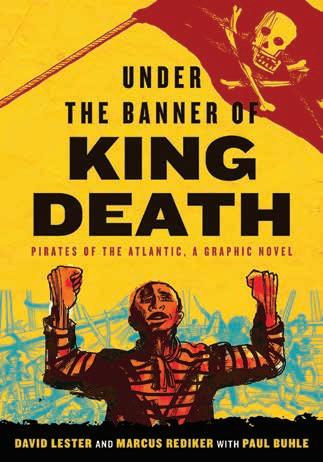
PIRATES OF THE ATLANTIC, A GRAPHIC NOVEL
David Lester & Marcus Rediker Edited by Paul BuhleDistribution by Penguin/Random House
ISBN: 9780807023983 • $17.95

“20 Canadian comics to check out in the first half of 2023!”
—CBC Books
“A real page-turner filled with sea battles , rescues , secret passion and unavoidable tragedy ... it’s a hidden treasure.”
—TORONTO STAR
Manolis Aligizakis, of White Rock, was one of ten poets longlisted for the prestigious Griffin Poetry Prize for his translation: Tasos Livaditis: Poems, Volume II (Libros Libertad $34.95). Livaditis (1922–1988) was a modernist Greek poet with leftist leanings caught up in his country’s post WWII turmoil and the following civil war when socialists and communists were persecuted. Manolis (known by his one-word pen name) was born in Crete in 1947 and immigrated to BC in 1973. He has published over 70 books in more than a dozen languages. In addition to his own poetry collections, Manolis has also translated several Greek poets in addition to Livaditis.

9781926763569
In her tenth book of poems, The Flaw (Ekstasis $23.95), Bowen Island’s Jude Neale draws upon the recent years of “forced contemplation” to write about “what will sustain our fragile world.” On one hand, Neale sees the vast potential of humanity; on the other, “the proliferation of apathy, hate, hopelessness and greed.” And like kintsugi, the Japanese art of mending and joining broken pottery shards with gold, Neale’s new poems offer the complicated comfort of embracing flaws and imperfections. “I have tried in this collection,” she writes, “to present a portrait in time of quiet moments of intimacy, grace, atrocities, anger, beauty and truth.”

9781771714785
What do you do when you leave a longtime job and then, shortly afterwards, your long-time relationship ends? In the case of Oriane Lee Johnston , program director for the Hollyhock Leadership Centre on Cortes Island for 16 years, she googled “Africa + Horses + Volunteer,” as she relates in her memoir, The Geography of Belonging: A Love Story of Horses & Africa (Salmonberry $25). The resulting journey led her to Zimbabwe, a wildlife safari on horseback, an enduring love affair with an African horseman, a wilderness conservation project and a

new lease on life. While Cortes Island is still her home, Johnston continues to return to the families, communities and wild places in Zimbabwe that she writes about.
9781777149222
Little is known about middle class women settlers who came to BC during the Cariboo gold rush in the late 1800s. UBC professor emerita Linda Peterat has remedied this with a meticulously researched book about three Danish sisters seeking a break from the constraints and traditions of their European homelands, as told in From Denmark to the Cariboo: The Epic Journey of the Lindhard Sisters (Heritage $26.95). The sisters, Laura, Caroline and Christine, were entrepreneurial in their own right, and they arrived in 1870 “attempting to seize the same opportunities as men while securing better futures for themselves and the next generation.” Peterat shows how they accomplished what they set out to do.

9781772033939
The book-length poem Bramah’s Quest (Nightwood $26.95), due out in July, is the second instalment of Renée Sarojini Saklikar’s epic fantasy saga in verse, The Heart of This Journey Bears All Patterns (THOT J BAP). The saga’s hero, time-travelling Bramah, is back on Earth on a quest to find her people. The year is 2087, and the planet is still ravaged by climate change and global inequality. The people working to restore good are seed savers, craftspeople, scientists and orphans. Also a meditation on good and evil, this book follows on from Bramah and the Beggar Boy (Nightwood, 2021).
9780889714304
Following upon her debut book of poems, Pots and Other Living Beings (Talonbooks, 2019), which combined her verses with selected photographs, annie ross anchors poems with woodcut prints in her second
collection of poetry, Some People Fall in the Lodge and Then Eat Berries All Winter (Talonbooks $19.95). She continues to express the pain of species extinctions, environmental injustice and the soul loss in modern life but juxtaposes these with animal rights and power, and keeping peace and love with Mother Earth in view. annie ross is a professor of First Nations Studies at Simon Fraser University. 9781772014396
The communities of South Fort George and Fort George which would eventually merge to become Prince George— had early reputations for being wild, unlawful settlements before the First World War—at one time even branded as Canada’s “most dangerous city.” But underlying this dubious, unfair assessment was local crime being blamed on mixed-heritage and Indigenous people, Jonathan Swainger argues in his lively book The Notorious Georges (UBC Press $32.95), due out in October. Publicity says “there was actually little to distinguish the Georges from the rest of a province that was admittedly a truculent place before the 1930s. And ‘respectable’ white residents were responsible for the lion’s share of the disorder.”
9780774869416
T
Former CBC radio producer and host, Margie Taylor has published her fourth novel, Rose Addams (NeWest $24.95), about a woman in her early sixties whose life is turning upside down. Rose’s daughter has given up on her PhD thesis and moved back home; she doesn’t see eye-to-eye with her son’s partner; her husband has been acting strangely and recently quit his university job; and there’s that young man who seems homeless and hangs around Rose’s library office.




Taylor’s author bio notes that this novel was written with a definite audience in mind: “women of a certain age who have raised their children and feel that the hard work is behind them. They tend, more often than not, to be wrong.”
9781774390696
annie rossBob the cat lives with his person, a girl named Pippa, in Jungle Cat (Orca $21.95) for ages 3–5, by Andrew Larsen , illustrated by Udayana Lugo of Richmond. But he often visits neighbours like Pearl the firefighter and Mario the chef. One day Bob dashes out of the apartment building into the dangerous city street. It requires all the neighbours to rescue him.
9781459834644
Ron Verzuh chronicles how Trail grew into a leading industrial town of the Kootenays in Printer’s Devils: How a Feisty Pioneer Newspaper Shaped the History of British Columbia’s Smelter City, 1895–1925 (Caitlin $28). Verzuh, who grew up in Trail, writes about the early proprietors of the Trail Creek News and gives an overview of some of the paper’s major news stories (including his grandfather’s frontpage obituary in 1916).
9781773861036
Sam Wiebe has released a fourth title in his Wakeland detective series, Sunset and Jericho (Harbour $24.95). Like previous Wakeland books, it’s set in Vancouver (Sunset and Jericho being two of the city’s beaches), now in the midst of an affordability crisis.
PI Dave Wakeland’s latest investigation has him breaking his own ethical boundaries. Wiebe’s series is in development for a TV show.

9781990776236
An aging couple leap to their deaths from a high-rise; a convenience store owner hopes to free his family from financial burdens by withholding evidence until a reward is available; a twin sister decides to run away with money the siblings had saved together, leaving the other twin behind. All are stories of unexpected exits in Paul Cresey’s debut collection of short fiction, Exit Strategies (Freehand $22.95).
The Victoria-based author’s stories have been published in Grain, Querty, and The Dalhousie Review

9781990601316
In Yolanda Ridge ’s third book— the middle-grade novel Elliot JellyLegs and the Bobblehead Miracle (Orca $12.95), illustrated by Sydney Barnes—an eleven-year-old boy, Elliot, desperately wants to succeed at playing hockey. But he can barely skate. Even as a goalie, his “jelly-legs” are obvious, and the game ends in embarrassment. Then Elliot makes a wish on his Carey Price Bobblehead, and his team starts winning. From publicity, this is a “story of friendship, hockey and believing in yourself.”
9781459833791
Governor General Award–winning poet David Zieroth tells of trips to Bratislava, Slovakia, and his affection for the place and friends there in his latest book of poems, the trick of staying and leaving (Harbour $22.95). “Can I write about a city I’ve merely / visited?—several times, mind you,” he wonders in the first poem. Then does so with 75 more poems on the subject.

9781990776021

After 33 successful years, Barb & Tom Pope are retiring and offering The Mulberry Bush Book Store in lovely Qualicum Beach for sale.

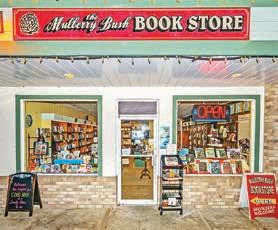
“With a poet’s ear for the perfect phrase and a scholar’s mind for critical questions that demand answers, Catherine Frazee explodes the complacency of ableism and demands that together we imagine otherwise to create a collective future ‘born from love of justice.’

She is a beautiful, witty, and deft writer who has made me think differently about myself, my beliefs, and my understanding.”


Shelagh Rogers, OC, host and co-producer, The Next Chapter, CBC Radio Order now from your local bookseller or at www.ubcpress.ca















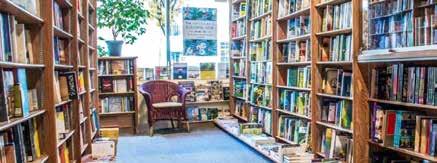

The first writer to receive the Vancity Book Prize for best book pertaining to women’s issues by a British Columbian was Sheila Baxter , who died December 19, 2022, surrounded by her close family in Vancouver.

Baxter wrote her award-winning title, Under the Viaduct (New Star, 1991), to recognize the plight of the homeless in BC and that publicized the lives of her neighbours who were living in skid row hotels, under bridges and on the streets.

Born on September 22, 1933, in London, England, she immigrated to Quebec in the fifties. A self-described “literacy guerilla” who was involved in poverty issues since 1970, Baxter raised five children and volunteered as a counsellor and welfare advocate at the Downtown Eastside Women’s Centre in Vancouver.
As an anti-poverty activist, Baxter interviewed women in 1986 and published No Way to Live: Poor Women Speak Out (New Star, 1988). Her third book, A Child Is Not A Toy: Voices of Children in Poverty (New Star, 1993), was followed by Still Raising Hell: Poverty, Activism and Other True Stories (Press Gang, 1997). It highlighted community initiatives in the Downtown Eastside for im-
Anvil Press...13
BC & Yukon Book Prizes...17


Banyen Books...37
BC Ferries Books...33
Beacon Press...34
Books On Mayne...37
Caitlin Press...26
Denman Island Writers Festival...10
Douglas & McIntyre...7
Dundurn Press...22
EVENT Magazine...29
Festival of the Written Arts...11
First Choice Books...39
Friesens Printers...39
Galiano Island Books...37


Harbour Publishing...40
Heritage Group of Publishers...8
Lorimer...29
Marquis Book Printing...39
Mulberry Bush Book Store...36
Mermaid Tales Bookshop...37
New Star Books...18
provements in health, education and housing.
Her play, Death in a Dumpster (Lazara, 2006) was a fictionalized drama that recalled the death of a homeless man who was crushed to death in a garbage dumpster.
The play caught the attention of Libby Davies, former MP for Vancouver East, who reflected on Baxter’s story: “When a dumpster becomes a refuge, what is the meaning of life in the city? Death in a Dumpster will tell you. Poverty is only a word but it is very loaded with life, death, grief, family and denial. This play is about that word.”
Rolf Maurer , who published three of Baxter’s books, said it was “a gift to have had a chance to work with Sheila,” adding that she was a force and inspiration to many. “It’s easy, reading her books, to see why. The scenes that are described, the stories that are told in those books are never just hers, they are the voices of the people she lived with and among, reflecting their experiences, and that she thought needed to be heard. She leaves a hole, but the place is better for her having been through it.”
I have enjoyed reading BC BookWorld for many years. It is such a feast to see so many good BC books being published and promoted locally. The book reviews make me want to buy a bag of “brain food.” I look forward to indulging myself in the next issue of BC BookWorld!
J.M. Speedie AldergroveThank you for selecting my book Allow Me: Poems 2000–2020 for review [Winter 2022, Vol. 36, No. 4]. Ms. Brooks was able to get to the heart of the collection, I felt, and expressed herself clearly and delicately. It’s been a particularly difficult year for me, so to have such a lovely review was a wonderful way to round out an otherwise dreary 2022.
Rhonda Batchelor VictoriaThank you for the well-written article about my memoir Meet Me in Cairo: Tales of Hitchin’ in the ‘60s [Winter 2022, Vol. 36, No. 4]. I thought it really captured the book. The quotes were great.
Jim Kerr VancouverMy sincere thanks for making me the I for Innes in Who’s Who [Summer 2022, Vol. 36, No. 2]. This issue also took me back to when, as a medical resident, I prowled the corridors of the old Vancouver General Hospital at the same time as Robert Krell. I was delighted to see his name mentioned in the review of Alan Twigg’s Out of Hiding. Bob and I crossed paths many times in those corridors. I look forward to reading each issue of BC BookWorld, so often coming upon familiar names. During the COVID-19 isolation, these updates were particularly welcome.
Roy Innes Gabriola IslandI was disappointed in the review of Phyllis Dyson’s Among Silent Echoes [Winter 2022, Vol. 36, No. 4] Phyllis’ book is about so much more than “life with a psychotic parent.” Phyllis and her brother were damaged much more by a system that placed them in the custody of uncaring relatives. The message I got from reading this book was that the memory of her mother’s love and care played a huge part in enabling Phyllis to survive and thrive despite her experience of foster care. The children were often needlessly kept apart from a mother they loved and who loved them. Their mother, Carolyn, was treated with contempt and disrespect by people in the system. Phyllis wrote her book in order to restore Carolyn’s humanity.
Anne Miles GibsonsMother Tongue Publishing...36
Nightwood Editions...30
Orca Book Publishers...2
Penguin Random House...4
People’s Co-Op Books...37

Printorium/Island Blue...39
Raven Chapbooks...25
Read Local BC...17
Ronsdale Press...4
Royal BC Museum...34
Sandhill Book Marketing...14
Talonbooks...18
Tanglewood Books...37
Tanner’s Books...37
Three-Day Novel Contest...22
Tradewind Books...26
University of Alberta Press...29
UBC Library...29
UBC Press...36
University of Toronto Press...25
Vancouver Desktop...29
Word Vancouver...10
Yoka’s Coffee...34
Discover
We offer to thousands of publishers:

• Manufacturing of all types of books and all types of binding
• Fast turnaround time and flexibility with all print run sizes
• Innovative integrated printing and logistics solutions

• Fast online book replenishment with Marquis Express


• Eco-friendly manufacturing options
• Optimal quality colour printing on all types of paper with our new carbon neutral UV press

